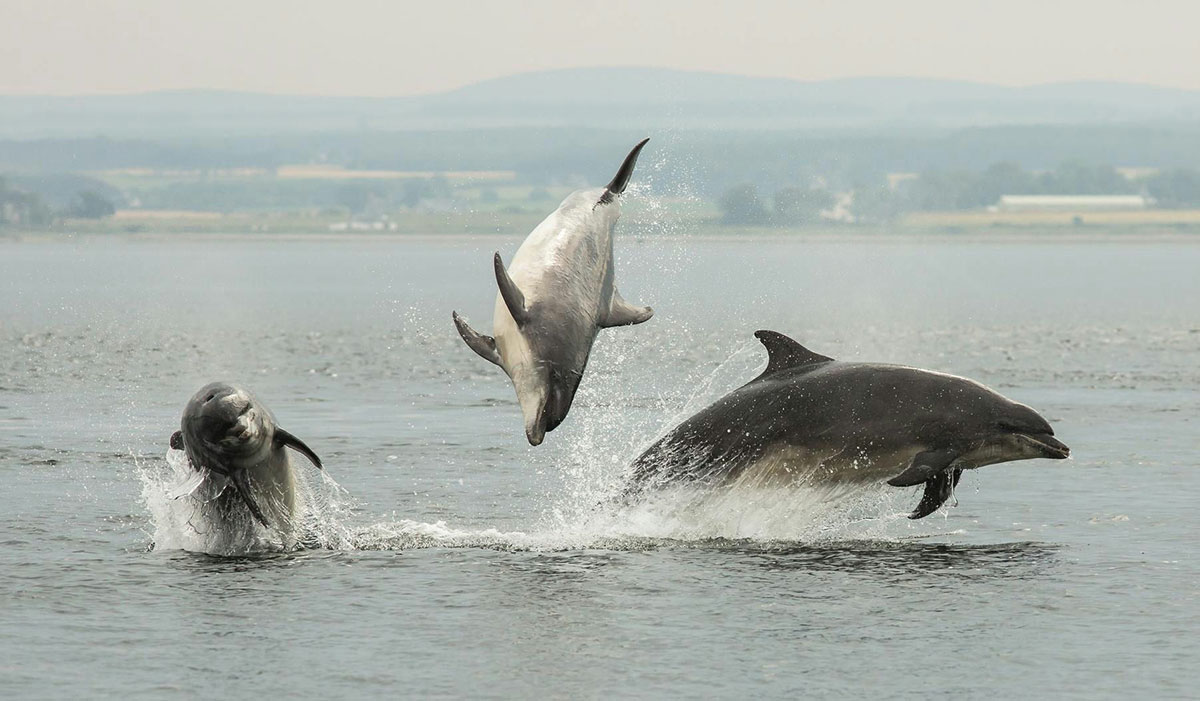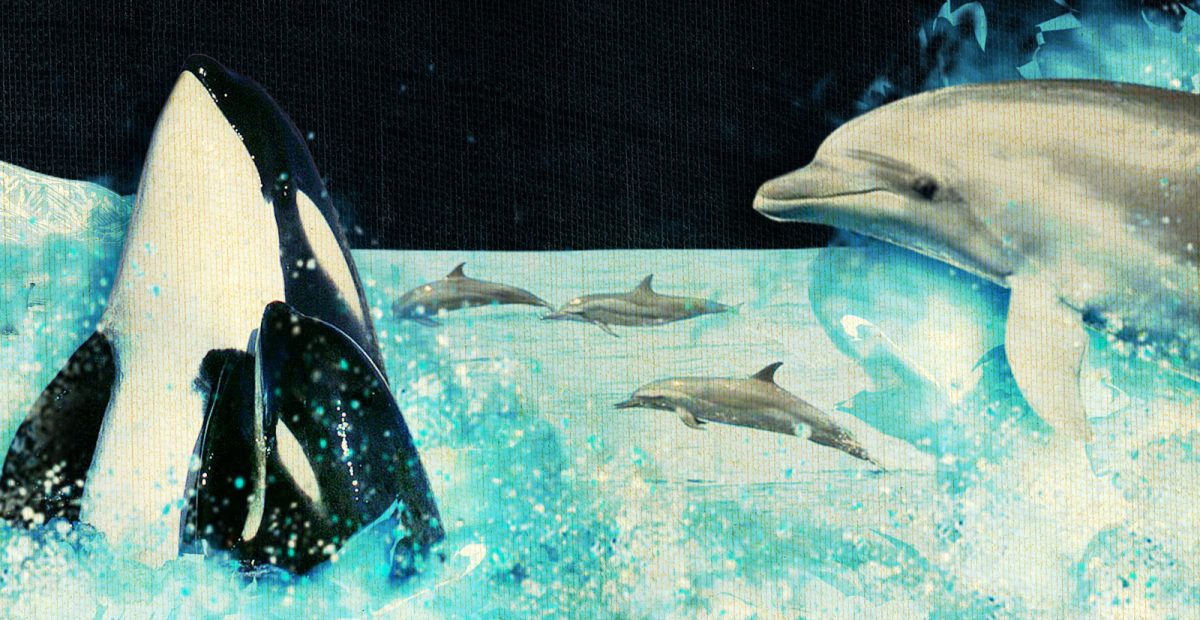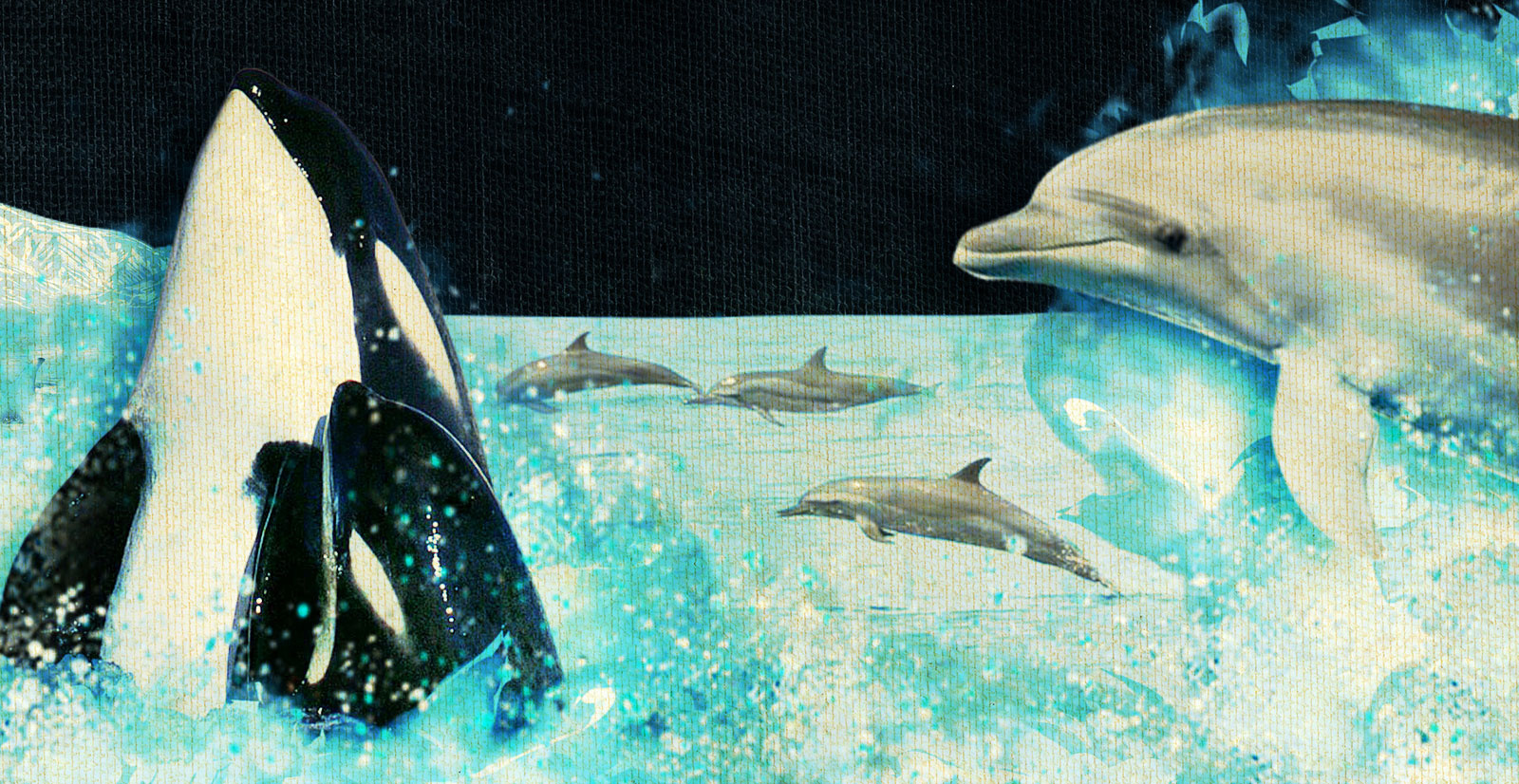
Current Situation
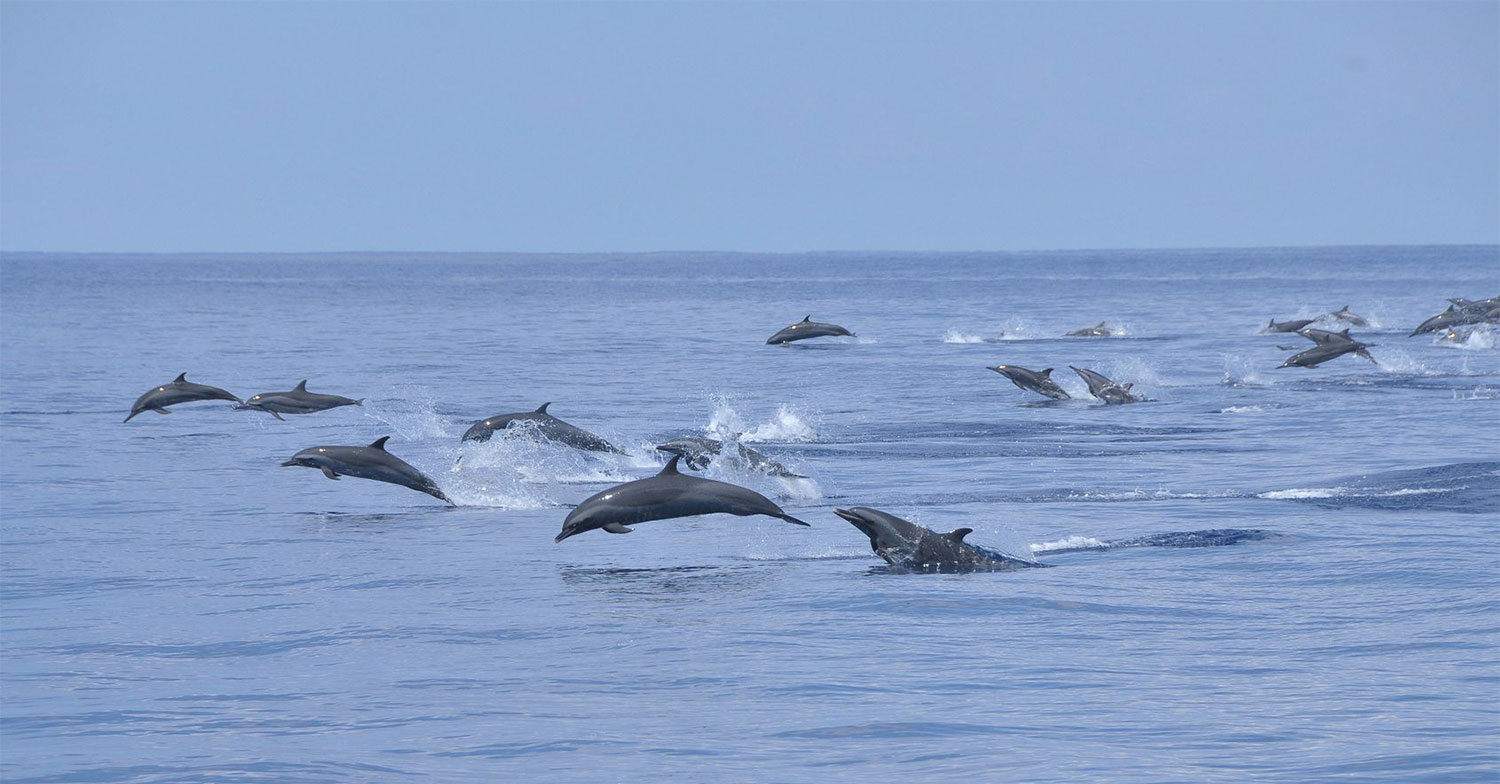
Human fascination with dolphins and whales has existed since the dawn of human history. Depictions of orcas from as early as 9,000 B.C. can be seen in the Leiknes granite fields of Norway and the Nazca lines of Peru. Fresco paintings of dolphins have been found on the excavated walls of a Minoan palace on the island of Crete, dated 1,700 B.C. Dolphins are even featured in numerous ancient Greek myths, depicting kindhearted, musically inclined creatures who often come to the aid of sailors in distress.
Our appreciation of cetacean beauty and intelligence has continued into the modern world. Marine aquariums like SeaWorld and Miami Seaquarium have become multibillion dollar businesses, with millions of visitors each year. Many people are drawn to aquariums for the opportunity to see these beautiful and highly intelligent animals, but they do not realize they are supporting a cruel industry. These captive animals have been violently kidnapped from their families in the ocean and are living unhappy, lonely lives.
Marine Aquariums and Water Parks

Twenty-two of the worlds 59 captive orca’s are held in Sea World aquariums
There are currently hundreds, possibly thousands, of marine aquariums and water parks operating throughout the world. Some are massive, billion dollar facilities found in major cities, while others are tiny operations located in rural areas in thirdworld countries. Over 200 licensed dolphinariums exist worldwide, not including unregistered ones in smaller countries. Thousands of captive dolphins, orcas, and other marine mammals suffer in these facilities, isolated from their family pods and natural habitat in the ocean. In the United States alone, more than 500 orcas, dolphins and other members of the dolphin family are held in captivity. These figures don’t take into account the tens of thousands who have died in captivity, succumbing to heightened stress factors immediately after capture or while trying to adapt to their new surroundings. In China, numerous aquariums and marine theme parks have been built over the last decade. A massive ocean marine park called the Shanghai Haichang Ocean Park opened in 2018 and is estimated to bring in six million visitors annually. Forty-three dolphinariums are located in Russia, containing approximately 160 dolphins and 60 Beluga whales.
However, SeaWorld is arguably the world’s most famous and wealthy marine aquarium chain. Twenty-two of the worlds 59 captive orca’s are held in Sea World aquariums.
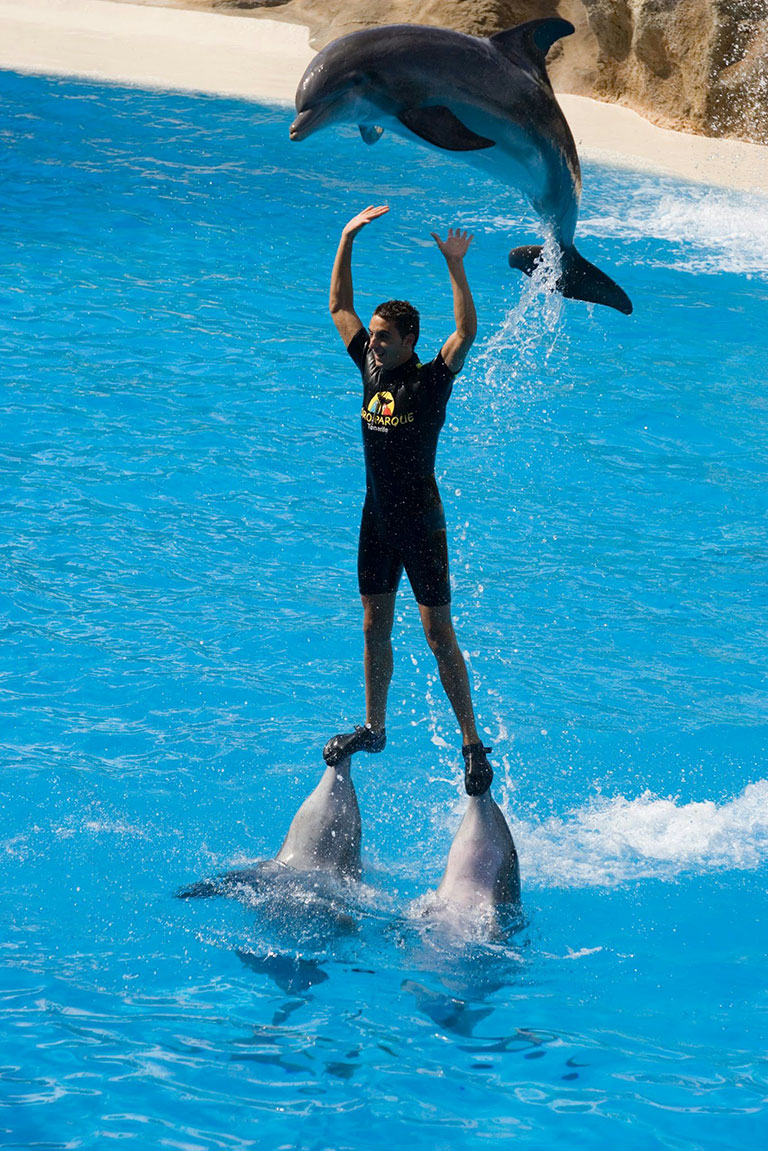
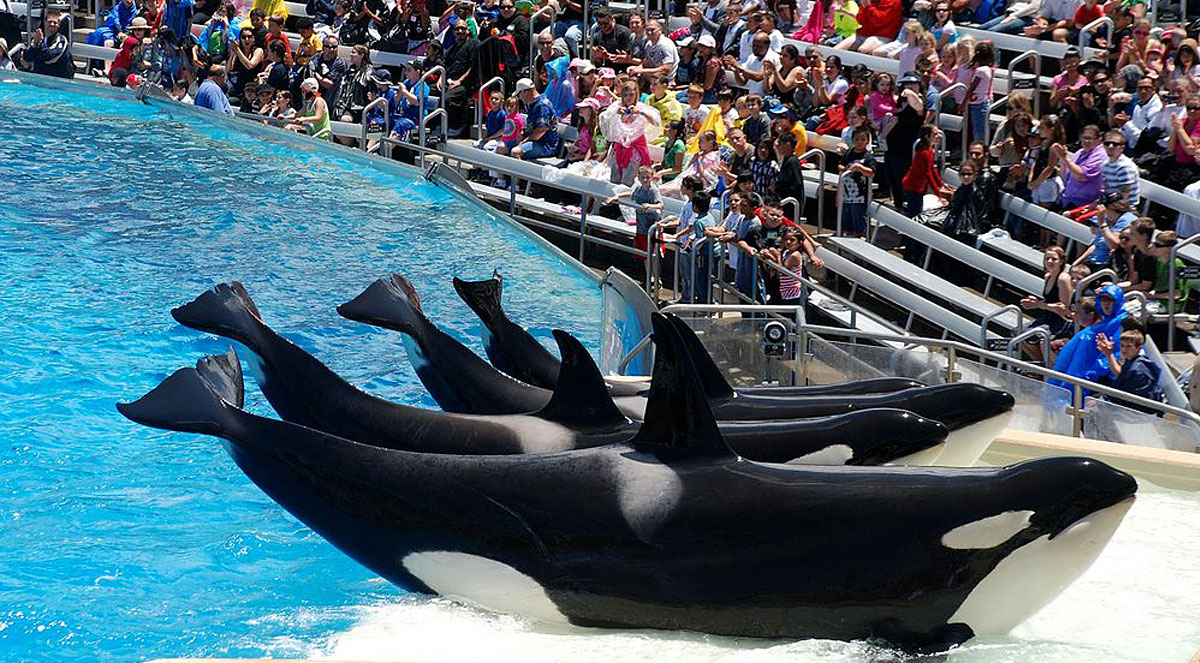
Swim with the Dolphins

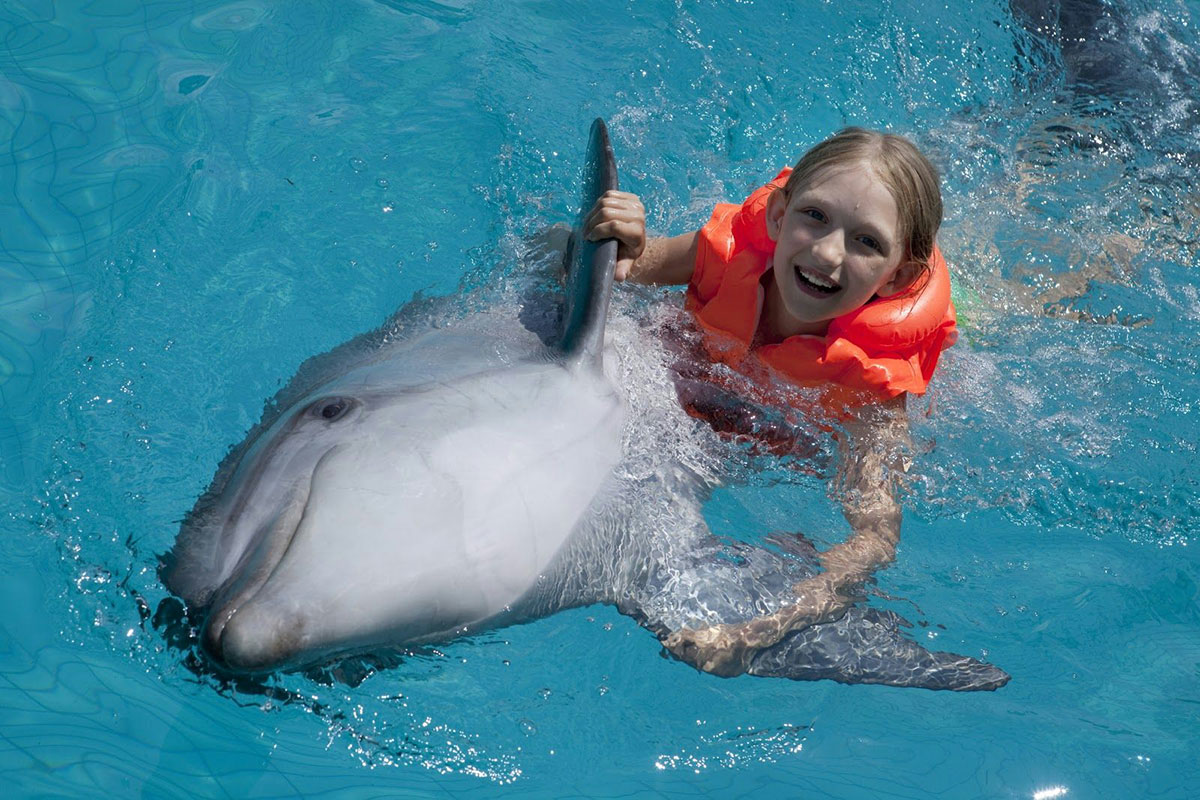
Swim with the Dolphins programs, also known as SWTD, are attractions where you can swim and interact with dolphins in captivity. Visitors at these venues can often hang onto a dolphin’s dorsal fin and be towed through the water, be pushed around the water by a dolphin’s beak, or be photographed kissing a dolphin, in addition to swimming with them in the pool or enclosed sea pen. Some facilities even allow the visitors to be dolphin “trainers” for the day. These attractions are extremely popular in the Caribbean, particularly the Bahamas, Jamaica, Dominican Republic, Grand Cayman, and Cancun, Mexico, with a huge number of visitors coming from Caribbean cruise ships. They are also popular in the United States and the Middle East, and becoming increasingly more popular in Asia. The programs seem harmless, as the dolphins are playful by nature and have a permanent smile, but they are actually very cruel and inhumane.
Some dolphins at SWTD facilities are captive born, but the majority are captured in the wild. The capture methods are all violent and very traumatic for the dolphins. Most involve high speed boats that chase dolphins into nets after separating them from their pods. In “drive hunts”, pods are herded towards the shore and shallow water, by banging pipes underwater to confuse and disorient them. After they are rounded up and trapped, the youngest and most attractive are taken, and the rest are typically stabbed and slaughtered. The capture is traumatic as the dolphins live in close knit social groups, and many die due to injuries or stress. Additionally many die during transit before they ever make it to these facilities.
Many dolphins that survive the capture and are brought into captivity, die within several months. They are distressed and disoriented, and taken to sea pens or concrete pools, where they are put in chemically treated and chlorinated water. In addition dolphins use echolocation in the wild. Echolocation is like a sonar that allows dolphins to “see” with sound, as they create sound waves that reflect and bounce off objects in the water. Because they are in small enclosed spaces opposed to the open ocean, the sound waves are literally bouncing off the walls, which causes confusion, discomfort and stress. Training methods are also cruel, and usually involve food deprivation, and the dolphins are kept hungry so they will interact and perform. In addition most of these facilities are poorly regulated, and are known to provide little or no veterinary care. Most dolphins in captivity die at a much younger age than they would in the wild.
Many SWTD programs falsely label themselves as educational or beneficial for dolphin conservation, but dolphins are not meant to be kept in captivity. In the wild they are known to travel up to 80 miles per day and do not belong in small sea pens or concrete pools, they belong with their pods in the open ocean. Please do not support Swim with the Dolphins programs.
Kidnapped from Their Ocean Home

Most dolphins, orcas, and whales found in marine aquariums and swim-with-dolphins venues were captured in the wild, stolen from their families. Even the few dolphins and orcas born in captivity are separated from their mothers within a year or two after birth, which is traumatic for both mother and calf. Dolphins and orcas in the wild normally live in the same pod with their mothers for their entire lives.
A majority of the dolphins currently being captured and sold to marine theme parks come from the waters around Taiji, Japan
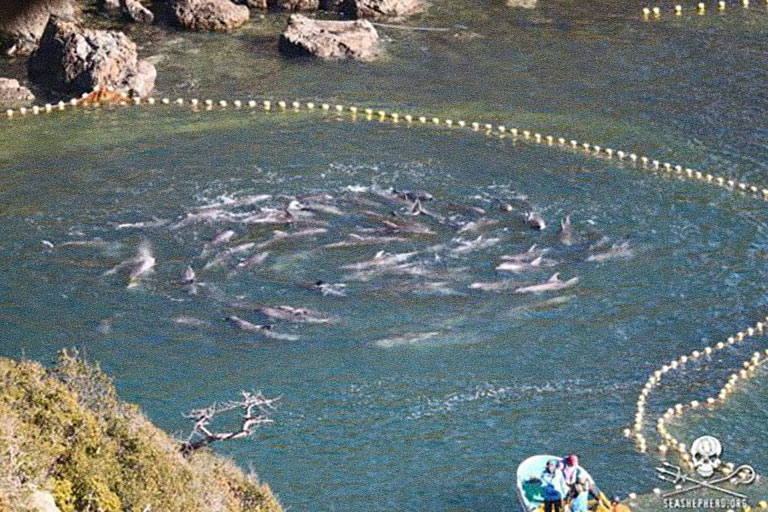
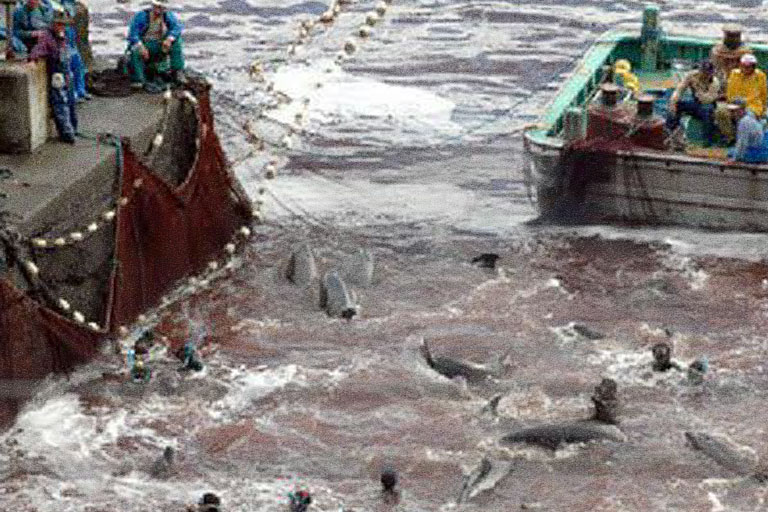
A majority of the dolphins currently being captured and sold to marine theme parks come from the waters around Taiji, Japan. Every year beginning in early September, thousands of dolphins are herded in open waters by local fishermen who lower steel pipes into the water and strike them with metal mallets. The booming sound produced at the bottom of the pipes in the water frightens and confuses the dolphins, who instinctively swim away from the noise into a nearby secluded cove. Once the dolphins are trapped in the shallow waters, the majority are then violently killed by the fisherman. The slaughtered dolphins are then auctioned off to local restaurants and stores to be sold as meat.
The dolphins that aren’t killed, mainly younger females, are sold by the fisherman to local brokers who, in turn, sell them to marine aquariums. One captive dolphin can sell for upwards of $50,000, the meat of a dead dolphin just hundreds of dollars. The sale of captive and butchered dolphins from Taiji in brings in millions of dollars for Taiji fishermen and brokers. During the summer months when the hunts are not being conducted, the Taiji Whale Museum hosts swim with dolphins events with unsuspecting tourists in the same cove that is used in the winter to capture and murder thousands of dolphins.
The annual Taiji dolphin drive was the subject of the 2009 movie documentary, The Cove. The film won the 2010 Academy Award for Best Documentary Feature and exposed to the world to the brutal reality of the dolphin industry in Taiji. The film’s main character, Ric O’Barry, is a world renowned dolphin expert who, after training dolphins in the 1960s, has since devoted his life to freeing dolphins from captivity and educating people about their intelligence, sensitivity, and complex social lives.
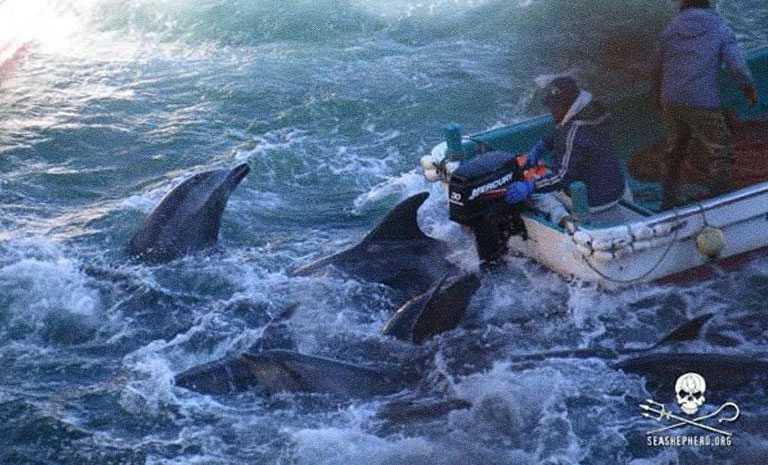
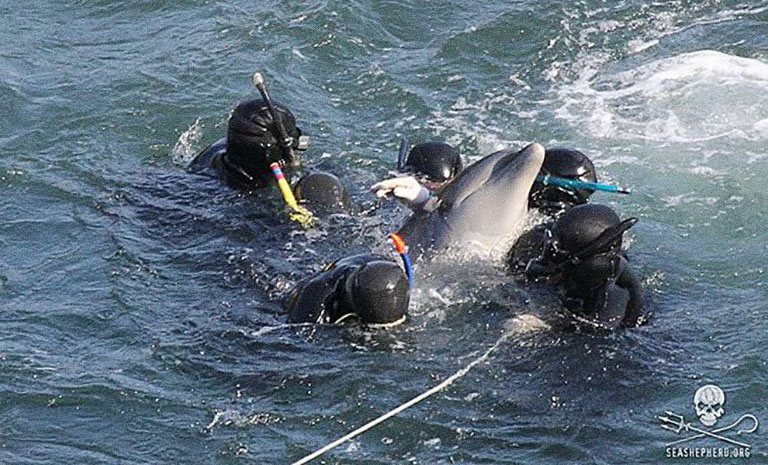
Catching orcas from the wild is no less violent and bloody. Captors use harpoons, hoop nets, gill and purse seine nets. One popular method called “bombing” employs loud explosives to frighten the orcas and drive them into shallow bays where they are then trapped in the nets. There are numerous accounts of orcas getting caught in nets and suffocating or bleeding to death from cuts inflicted by the razor-sharp twine. Click here to see a two-part video that aired on CNN documents the capture and confinement of orcas from the wild.
One popular method called “bombing” uses loud explosives to frighten the orcas…
Training Methods

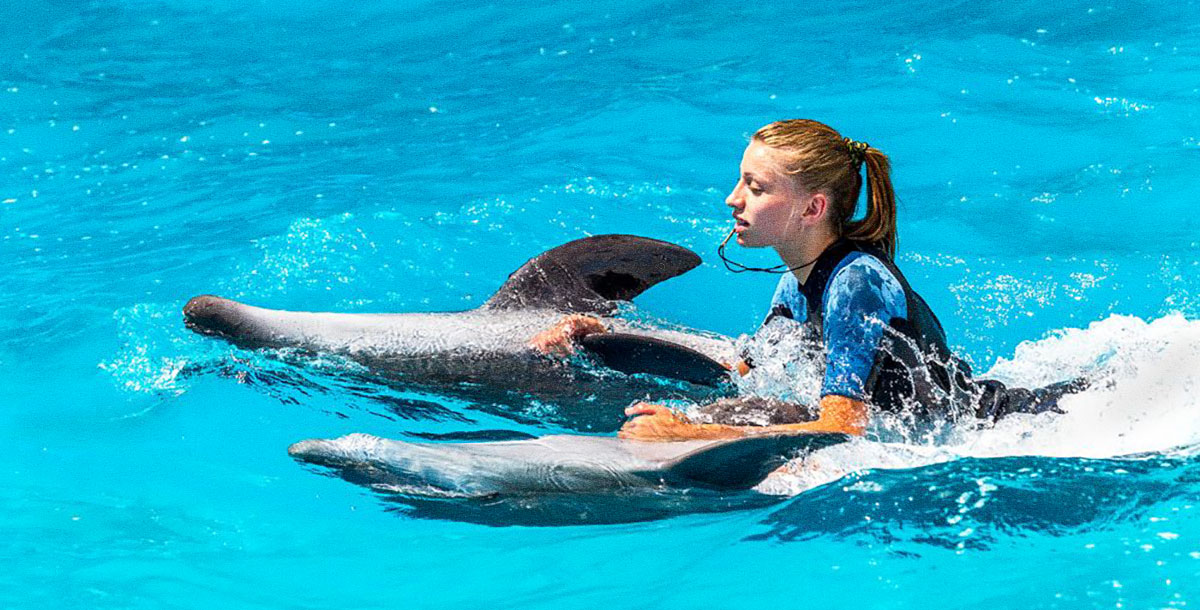
After the traumatic experience of their capture and sudden loss of family and pod, the dolphins and orcas are placed in holding pools and become further weakened due to their forced adaptation to the chemically treated, artificial seawater. The animals instinctively know their bodies need food in order to survive in the compromised circumstances in which they now find themselves. Trainers exploit this weakness to train them to perform tricks and unnatural behaviors. The captured dolphins and orcas soon realize the only way they will consistently receive food is if they perform these unnatural actions. Personnel at holding facilities and aquariums have often misled the public into believing the bond of trust between the animal and trainer is the main facet of training. The truth, however, is the dolphins and orcas have no choice but to perform the unnatural behavior in order to survive.
An additional debilitating aspect of training is that the dolphins and orcas are, for the first time in their lives, forced to restrict the use of their highly developed sonar echolocation because they are now living in such tiny enclosures. This may be the most damaging aspect of captivity.
The captured dolphins and orcas soon realize the only way they will consistently receive food is if they perform these unnatural actions
For every dolphin or orca that is trained to perform in a water park, there are others who die in captivity because they’re unable to adapt to the new conditions. Aquariums and water parks don’t talk about them. Nor do they talk about the recorded instances of dolphins and orcas who simply chose to starve themselves to death while in the holding pools, rather than than living the rest of their lives in captivity.
Life in a Pool

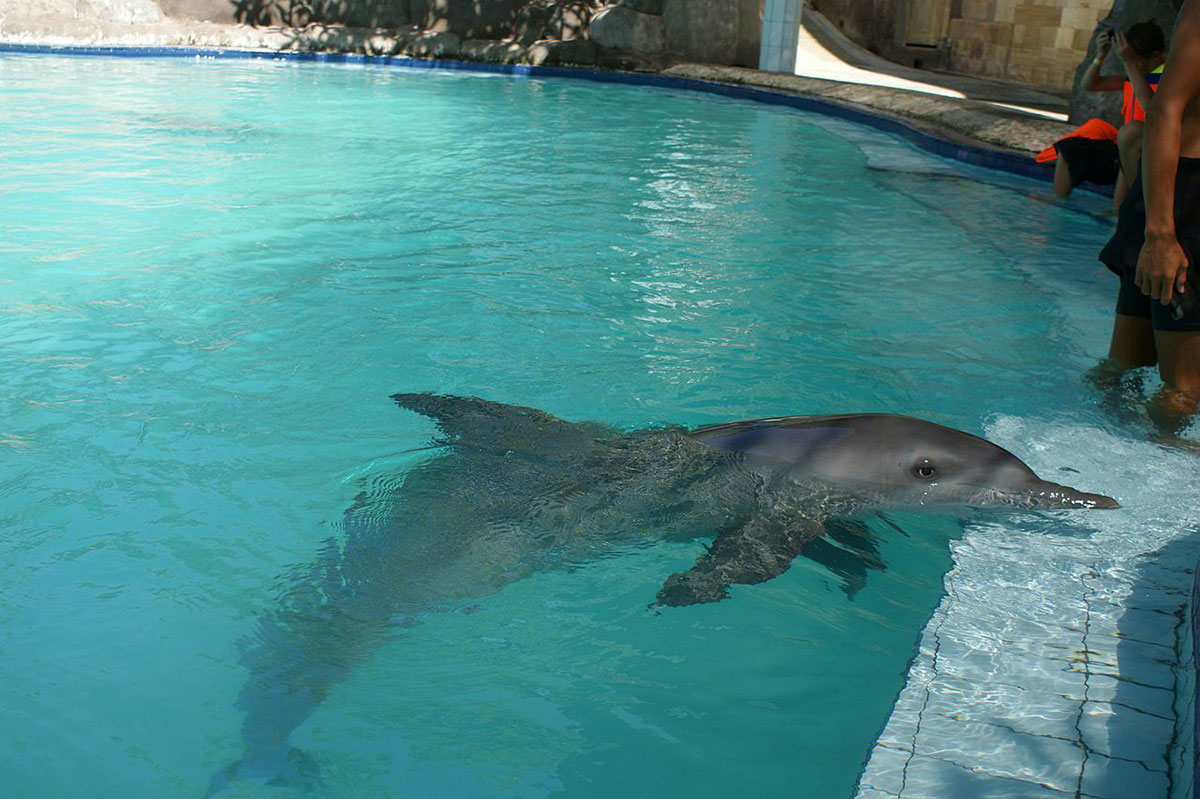
Wild whales, orcas and dolphins normally swim up to 100 miles a day. A concrete tank or confined lagoon can never replace their home in the ocean. An orca or dolphin at SeaWorld would have to swim the circumference of the main pool 1,900 times in one day to swim the same distance it might swim on an average day in the wild. Moreover, these sensitive animals in the wild would never encounter the loud music, fireworks, and boisterous audiences they are subjected to when performing three times a day in a cramped water park.
When not performing, the orcas and dolphins are usually kept in holding tanks even smaller than the show pools. Captive orcas residing in the same facility often experience tension and aggression, as they are from different pods in the wild and speak different languages. The confined space and overall stress of captivity has often resulted in deadly fights between orcas. In the wild, orca pod societal rules and hierarchy prohibit serious violence against one another; when disagreements do occur, the submissive orca can find space to flee. In captivity, there’s nowhere to go, which has led to both serious injuries and death. Former SeaWorld water quality diver Sarah Fischbeck said that in her six years working at the San Diego SeaWorld, from 2007-2013, she and other divers routinely found pieces of orca skin at the bottom of the tanks, ripped off by the teeth of other attacking orcas. According to Fischbeck, the orcas, dolphins, and beluga whales were in a constant state of agitation with one another due to the cramped and unnatural conditions of the tanks. It was common to witness attacks between the animals, some deadly. SeaWorld tried to lesson the aggression by feeding them sedative drugs, but it did little to help.
No matter how state of the art or modern an oceanarium or marine park is, the fact is they can never replicate the diverse stimulation of the ocean. Nor can they meet the complex physiological and psychological needs of these complex, intelligent animals. In August of 2015, evidence of physical and mental trauma experienced by dolphins, orcas, and other marine animals held in captivity was observed by veterinarian Heather Rally. While visiting the SeaWorld location in San Antonio, she observed skin abnormalities including lesions, infections, scars, and open wounds on many of the animals. Furthermore, most of the animals were exhibiting repetitive behavior as a result of the lack of stimulation in the tanks. In October of 2015, The Georgia Aquarium announced that Maris, a 21 year old Beluga whale had died suddenly and without cause. Maris had lived through the death of two newborn baby calves at the aquarium in the previous two years.
Debilitating Health and Long Term Depression

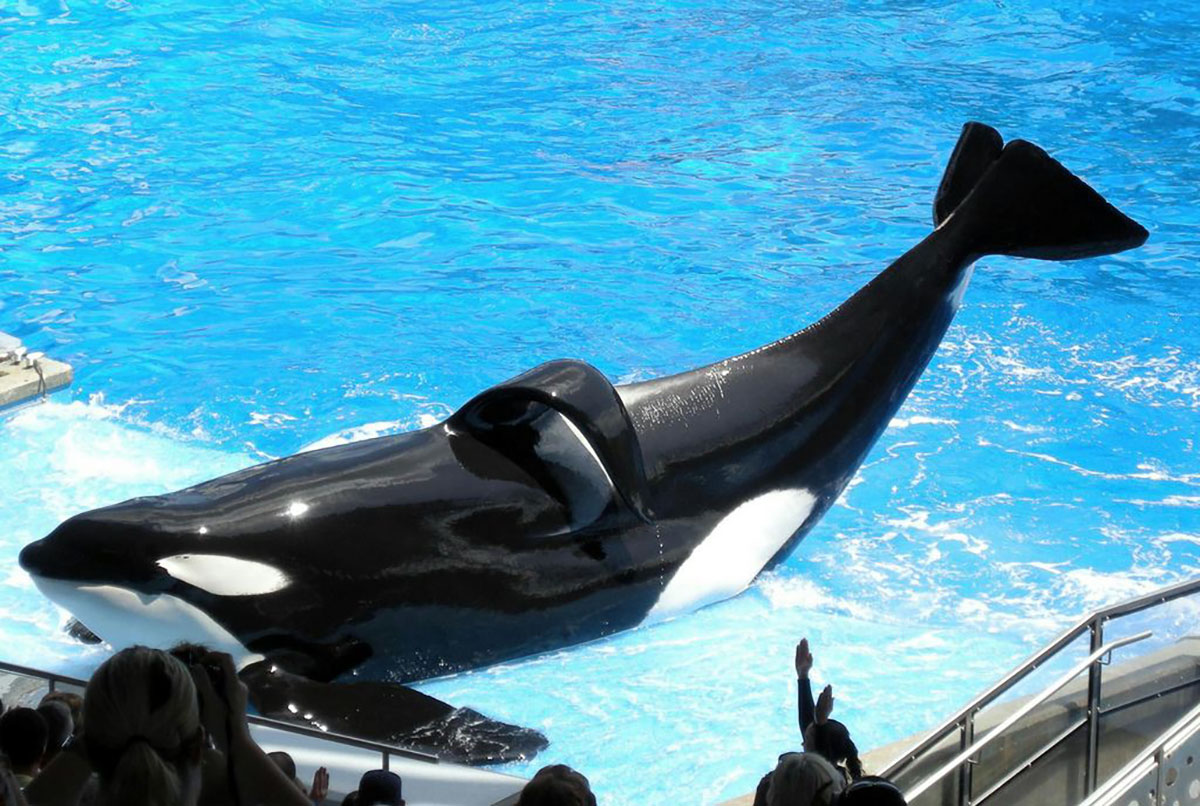
The mental, emotional and physical stress that captive cetaceans suffer weakens their immune system and makes them prone to infection and disease. They usually die much younger than whales and dolphins in the wild. The death rate for infant whales and dolphins is also much higher in captivity. Orcas and dolphins in captivity will gnaw at iron bars and concrete from stress, anxiety, and boredom, resulting in broken teeth and painful dental complications.
Dorsal fin collapse is extremely rare in the wild and is a sign of disease or serious injury
Almost all male captive orcas, and some females, have a dorsal fin that is partially or completely collapsed to one side. This abnormality develops from a combination of stressors, including dietary change, lowered blood pressure from reduced activity, overheating from prolonged exposure to sunlight, and decreased water pressure supporting the fin. Dorsal fin collapse is extremely rare in the wild and when it does occur, it is a sign of disease or serious injury. Some marine biologists suggest it is the sign of long-term emotional sadness in the captive animals. Evidence shows that captive dolphins, orcas, and whales suffer greatly from Post Traumatic Stress Syndrome (PTSD), often exhibited as listlessness, repetitive behavior, emotional detachment, and aggression towards the self and others. Scientific studies now show that PTSD also affects the oceanic pods. Remaining pod members who have had a family member violently taken away mourn the loss for years.
Growing Public Outcry Against Captivity

In the last decade, beginning with the documentary movie The Cove and most recently with the hugely successful documentary Blackfish, public outcry over cetacean captivity has been steadily growing to unprecedented heights. Famous celebrities have publicly decried the practice, and progressive governmental officials at the municipal, regional, and state levels have begun lending their support by introducing legislation aimed at ending cetacean captivity. Through the tireless work of numerous dolphin, orca, and whale advocacy organizations, millions of people throughout the world are being educated about cetacean captivity and are being urged to demand an end to the exploitation of these magnificent creatures. Still, thousands of innocent and abused dolphins, orcas, and whales are held in captivity. Further action is required to put an end to this horrible practice once and for all.
Public outcry over cetacean captivity has been steadily growing to unprecedented heights
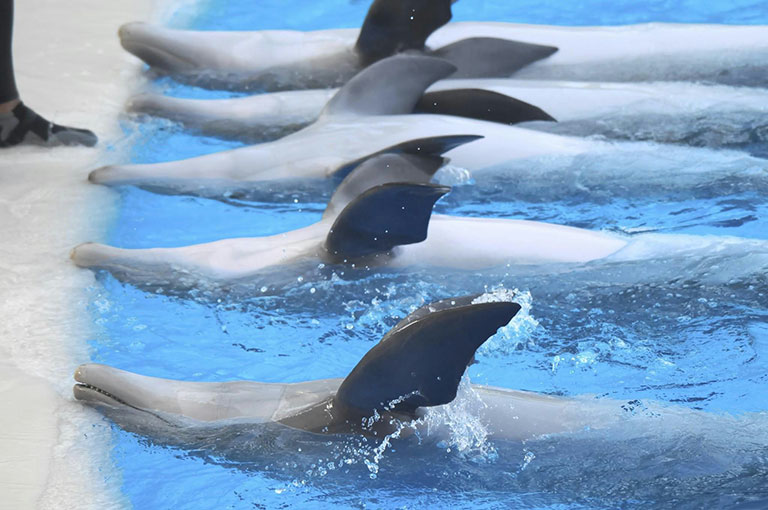
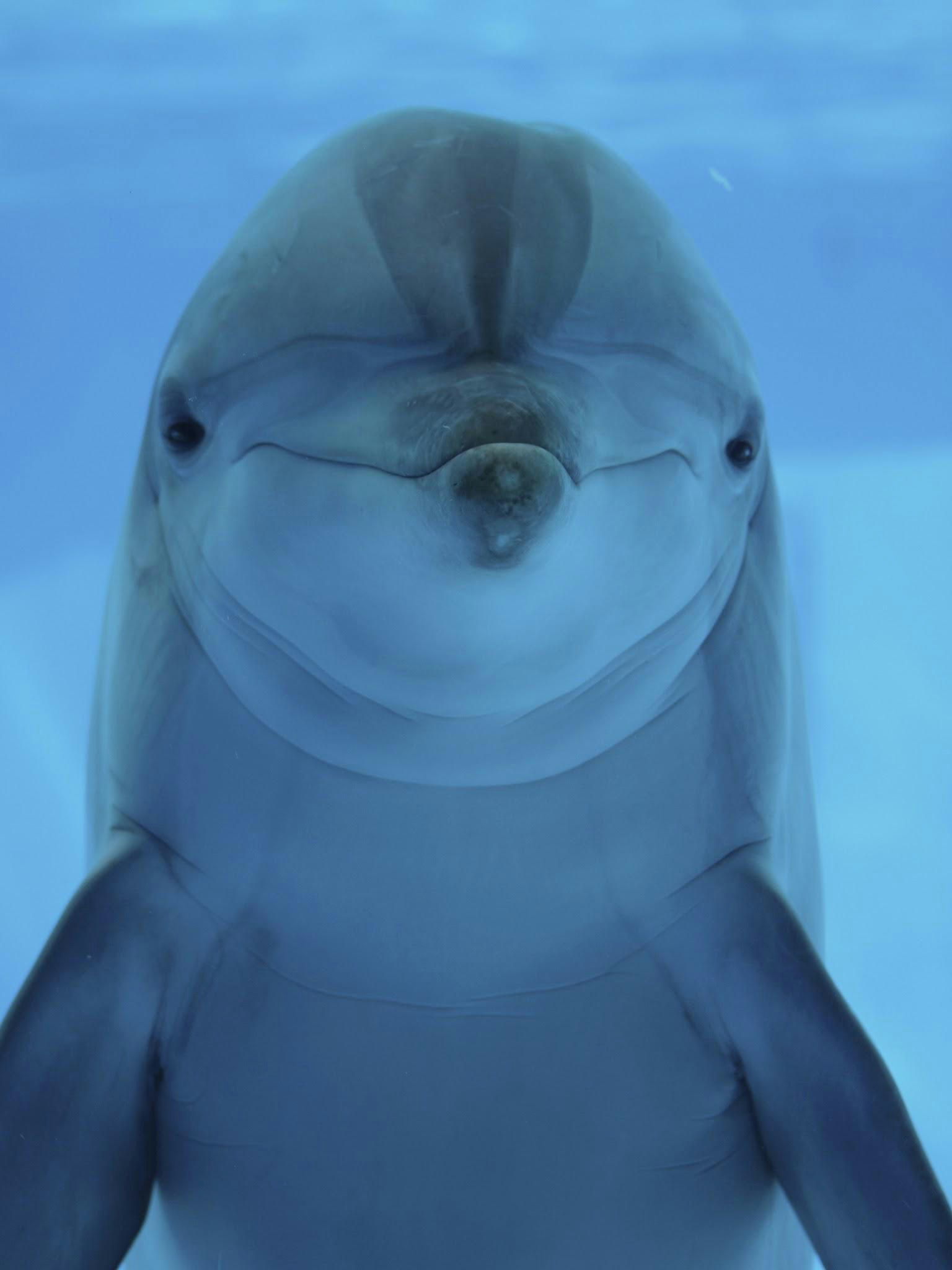

Positive Change
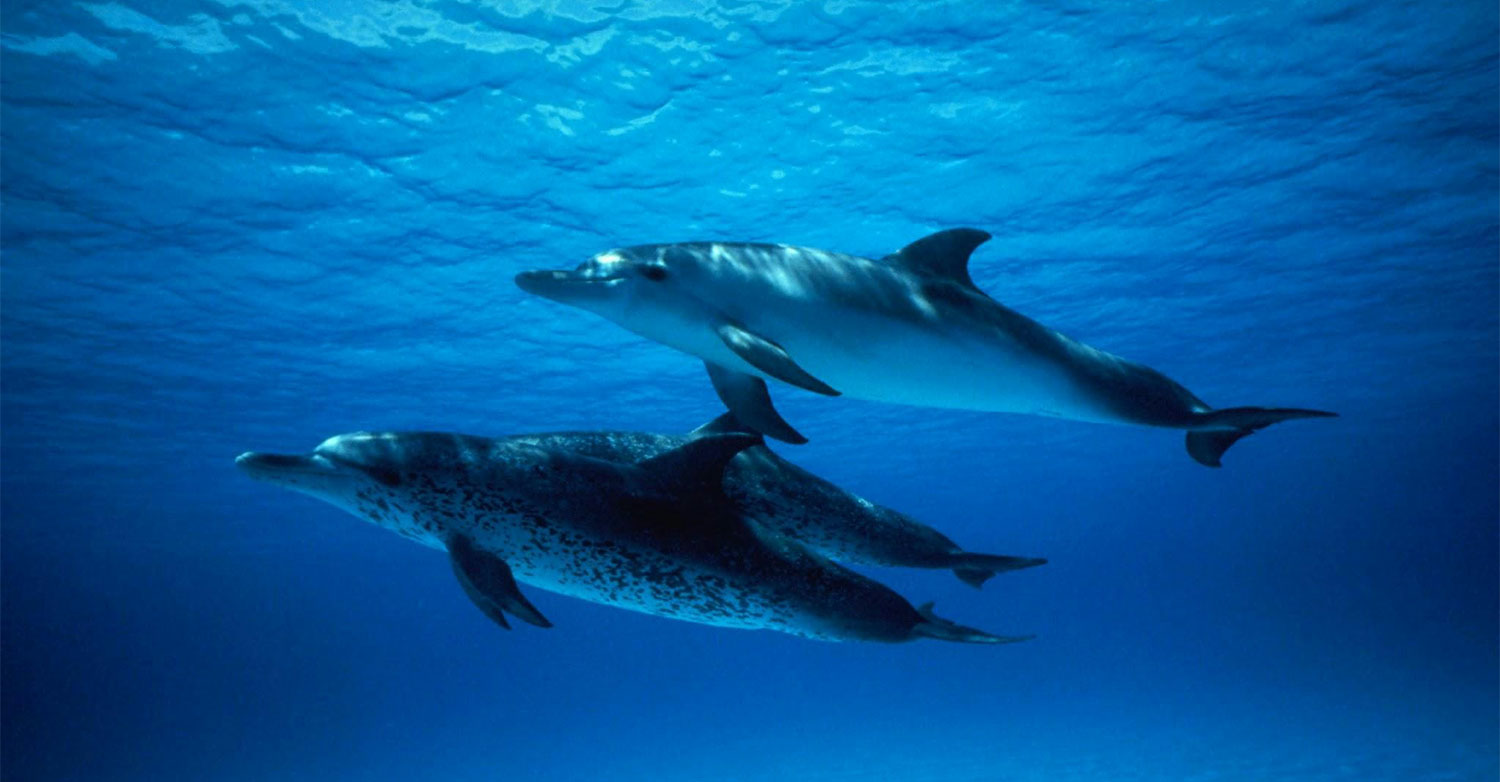
Many countries have already phased out cetacean captivity while pressure is mounting on those where it is still allowed. A striking example is the United Kingdom, where in the early 1970s no less than 36 dolphinariums and traveling dolphin shows existed. However, due to public pressure and governmental policies, the last British dolphinarium closed its doors in 1993. Cetacean captivity was banned in Hungary in 2002 and is no longer allowed in Bolivia, Canada, Cyprus, Croatia, Greece, Nicaragua, Switzerland, Norway, Luxembourg, or Slovenia. Furthermore in 2013, India, the world’s largest democracy, passed legislation banning cetacean captivity, and officially declared dolphins as “nonhuman persons”. And most recently in September 2020, France announced an immediate ban on the acquisition or breeding of dolphins and orcas in captivity at marine parks. Cetaceans already held in captivity will be phased out, and eventually transferred to sea pens to spend the remainder of their lives in a more natural environment. The new rules also ban direct contact between animals and the public, including swimming with dolphins, and require pools holding the animals to be made significantly larger.
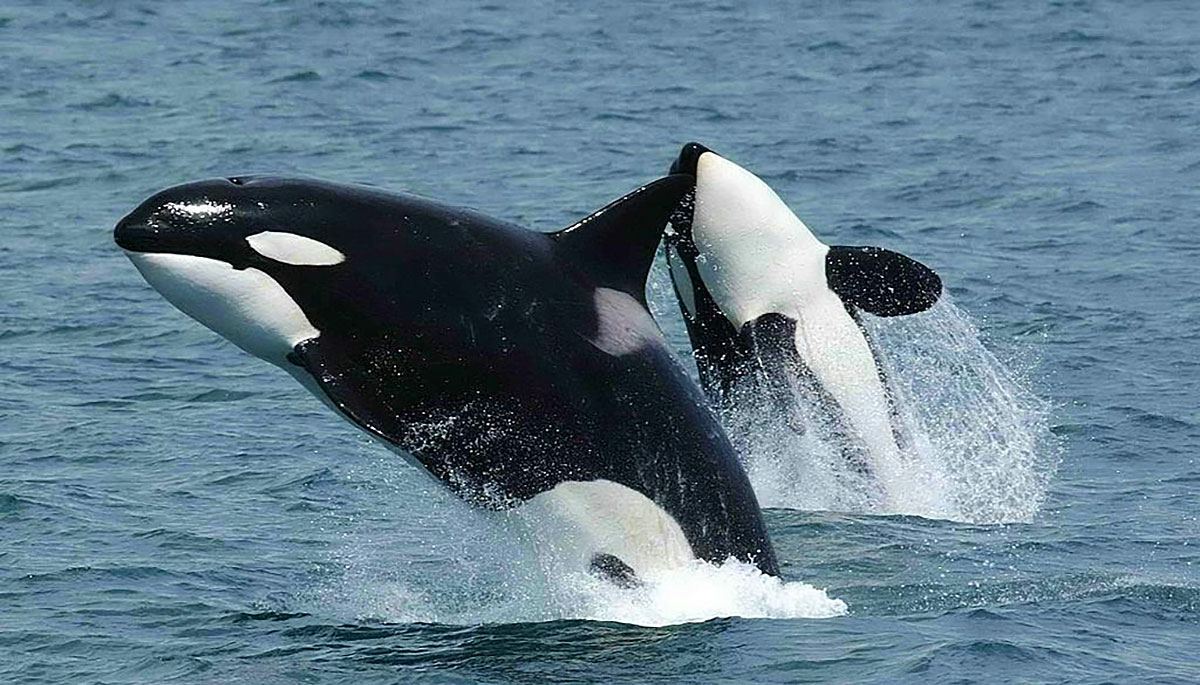
In the United States, where a significant portion of the world’s captive orcas, dolphins, and whales reside, a monumental step was taken in October of 2014 when the city of San Francisco put into law the Cetacean Free and Safe Passage Resolution, which declared whales and dolphins have the right “to be free of captivity, and to remain unrestricted in their natural environment…and be guaranteed free and safe passage in San Francisco’s coastal waters, San Francisco Bay, and its estuaries.” Furthermore, legislation entitled The Orca Welfare and Safety Act was passed in the state of California in 2016, which bans the use of orcas as performers in theme shows, ends captive breeding programs and ends the import and export of orcas in and out of the state. This is a significant blow to SeaWorld, as SeaWorld San Diego has ten captive orcas, more than any aquarium in the world. This is the first such law in the United States and a massive step forward towards a future national ban on cetacean captivity in the US. The 10 orcas currently at SeaWorld San Diego will remain there but the new law makes it illegal to breed them, use them in performances, export them or import other orcas from either the wild or other aquariums
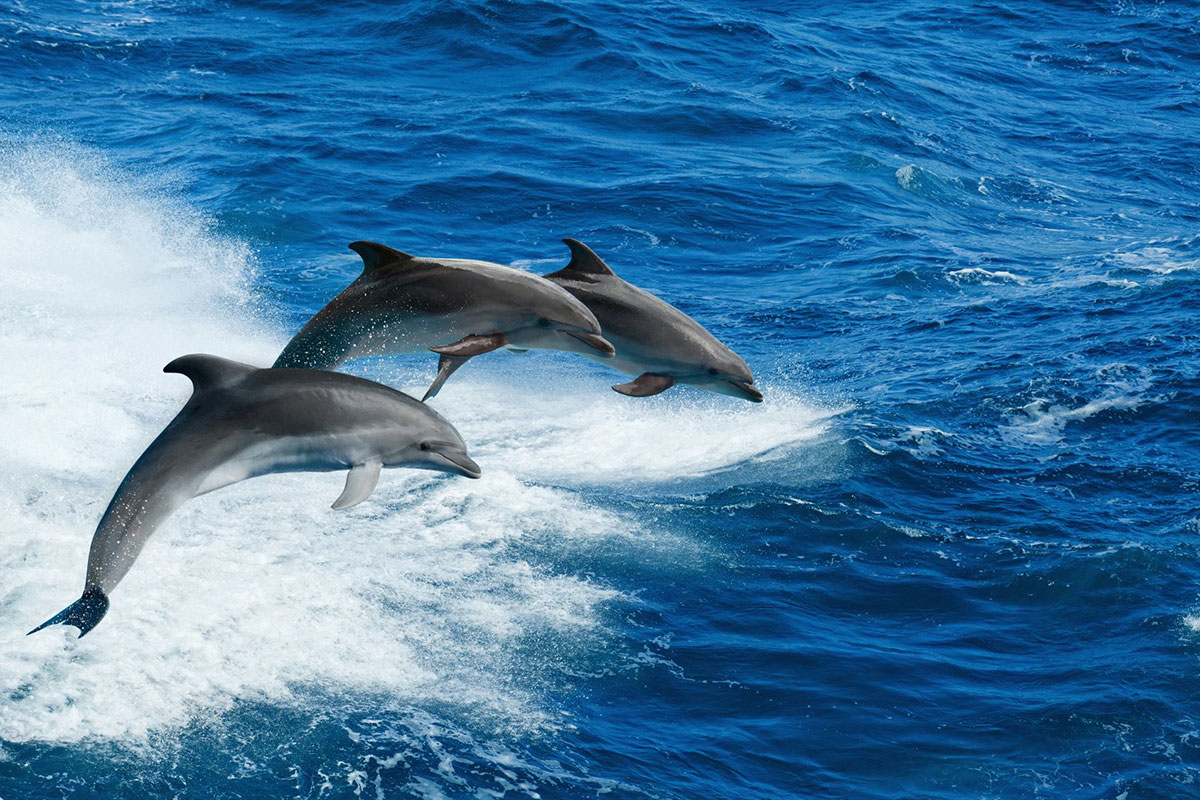
In July of 2014, Justice Stephen Isaacs, a judge in the Bahamas, ordered a company that owns a dolphinarium holding eight captive dolphins to shut down the facility and release the animals back to the ocean. Just as encouraging was Justice Isaacs’ official court statement, which questioned the legality of holding dolphins in captivity for the purpose of human entertainment.
In October of 2015, the California Coastal Commission unanimously approved San Diego SeaWorld’s plan to double the size of its orca habitat, under the condition that they no longer breed them. This decision effectively stops the breeding program at the facility while nearly doubling the size of the tanks currently used to house the orca’s currently held in captivity at SeaWorld San Diego. SeaWorld responded by filing a lawsuit against the Commission. The very next month, California U.S. Congressman Adam Schiff introduced the Orca Responsibility and Care Advancement (ORCA) Act, which, if enacted, will phase out the public display of captive orcas in the United States. Schiff said, “The evidence is very strong that the psychological and physical harm done to these magnificent animals far outweighs any benefits reaped from their display. We cannot be responsible stewards of our natural environment and propagate messages about the importance of animal welfare when our behaviors do not reflect our principles.” The ORCA Act would, also, ban the capture or import of orcas for the purpose of public display, the export of orcas for public display, and the breeding of orcas for exhibition purposes.
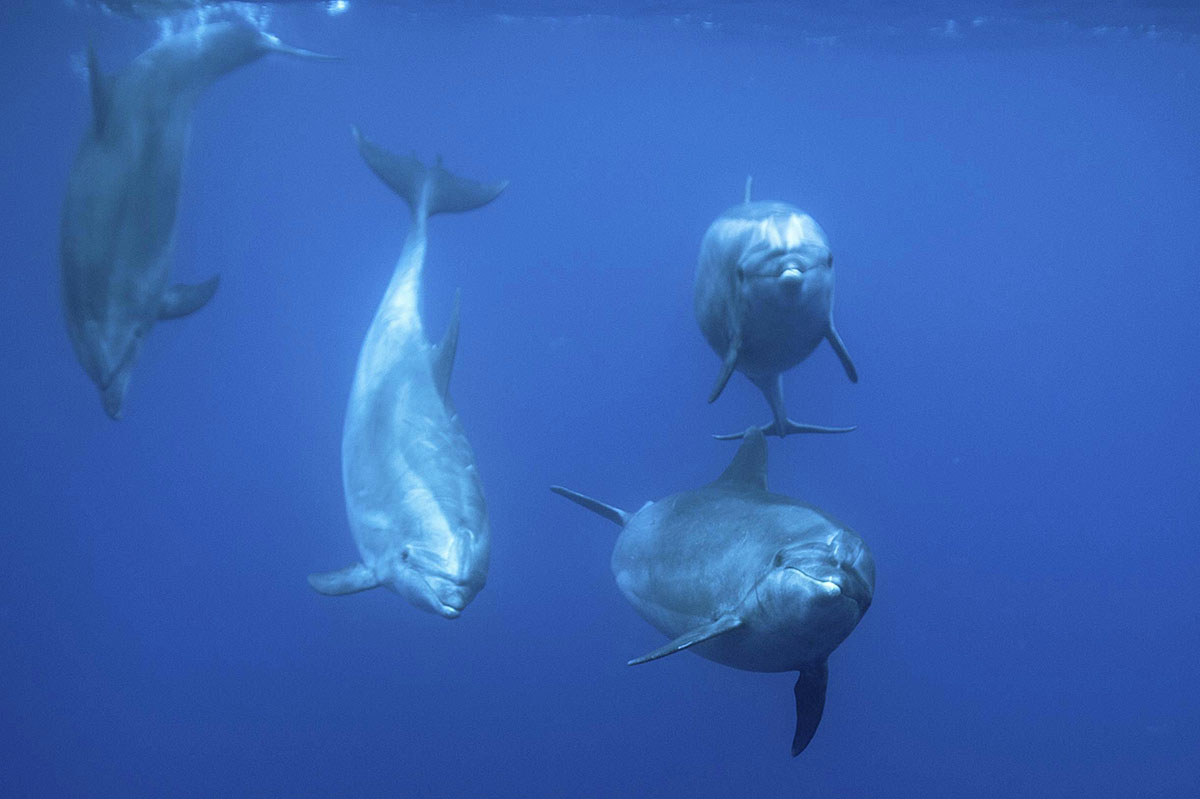
The Cove

Much of the current momentum in the movement to ban dolphin captivity and the slaughter of dolphins for meat can be traced back to the highly influential documentary film The Cove, released in 2009. The film was awarded the 2010 Academy Award for Best Documentary and was directed by former National Geographic photographer Louie Psihoyos of the Oceanic Preservation Society. It follows dolphin activist Ric O’Barry and his mission to expose the cruel dolphin hunting and captive dolphin trades based in Taiji, Japan. Since its release, countless people and organizations have been moved into action, protesting the annual dolphin drive (which also accounts for many orca and pilot whale deaths) and bringing worldwide scrutiny to the captive dolphin industry. Numerous celebrities and political figures from across the globe have have expressed outrage at the annual Taiji dolphin drive, including Russell Simmons, Sean Penn, Jennifer Hudson, Gwyneth Paltrow, and Oliver Stone. In early 2014, they wrote a letter to the American Ambassador to Japan, Caroline Kennedy, urging her to confront the Japanese government concerning the issue. Within days Ambassador Kennedy publicly stated that she is ”deeply concerned by the inhumaneness of drive hunt dolphin killing” and the “United States Government opposes drive hunt fisheries.”
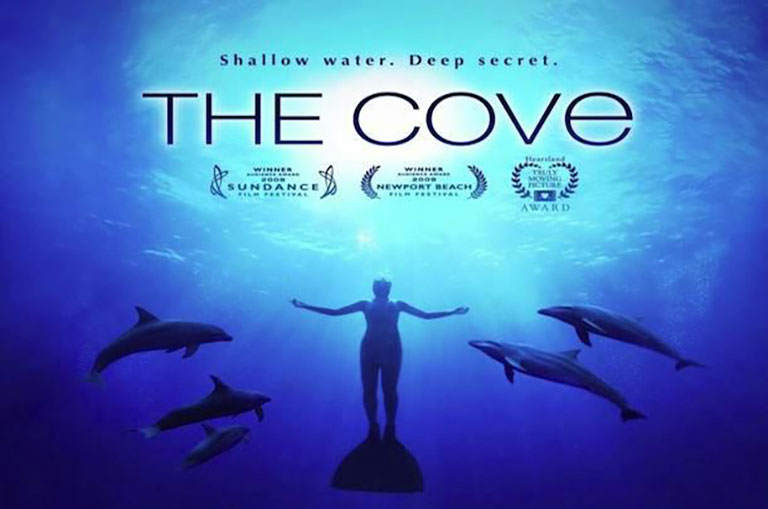
The Cove has inspired many Japanese citizens and animal rights groups to stand up and demand change
Most importantly, The Cove has inspired many Japanese citizens and animal rights groups to stand up and demand change. Japanese activists have organized forums discussing dolphin captivity and the dolphin meat industry and hosted screenings of The Cove in Tokyo and other Japanese cities. The film has educated millions of Japanese to the Taiji dolphin drive and shed light on the captive dolphin industry. It has also inspired many Japanese to visit Taiji and witness the horrific hunts themselves.
The Blackfish Effect

Probably no animal rights film has ever had as much impact as the 2013 documentary, Blackfish. The film, directed by Gabriella Cowperthwaite, focuses on the captivity of Tilikum, an orca who has been involved in the deaths of three humans since his capture in 1983 off the coast of Iceland. Through interviews with marine biologists and former SeaWorld trainers, the film concludes that keeping orcas captive is not only cruel and inhumane, but it is dangerous for their human trainers due to the captive conditions which make the orcas depressed and aggressive. The film has received rave reviews and has aired on CNN multiple times. Nearly 21 million people watched Blackfish when it first aired in October 2013.
Since the release of the film, attendance at SeaWorld has decreased and SeaWorld stock prices have dropped significantly
Public reaction and the ripple effect of the film has been unprecedented. Since the release of the film, attendance at SeaWorld has decreased and SeaWorld stock prices have dropped significantly. Reaction to the documentary prompted famous bands and singers The Beach Boys, Willie Nelson, Heart, Pat Benatar, Barenaked Ladies, Martina McBride, .38 Special, Cheap Trick, REO Speedwagon, Trace Adkins and Trisha Yearwood to cancel their concerts at SeaWorld Orlando and Busch Gardens Tampa (owned by SeaWorld). The cancellations caused a $15.9 million loss for SeaWorld. Since the release of the film, grade school and high school students across the United States have successfully lobbied their schools to cancel field trips to SeaWorld. Social media posts from young adults have been extremely critical, many calling for a boycott of SeaWorld. Demonstrations have taken place at all three American SeaWorld locations.
Reaction to the documentary prompted famous bands and singers The Beach Boys, Willie Nelson, Heart, Pat Benatar, Barenaked Ladies, Martina McBride, .38 Special, Cheap Trick, REO Speedwagon, Trace Adkins and Trisha Yearwood to cancel their concerts at SeaWorld Orlando and Busch Gardens Tampa (owned by SeaWorld). The cancellations caused a $15.9 million loss for SeaWorld. Singer Harry Styles of the band One Direction implored the crowd, at his concert in San Diego in July of 2015, not to visit SeaWorld. Since the release Blackfish, grade school and high school students across the United States have successfully lobbied their schools to cancel field trips to SeaWorld. Social media posts from young adults have been extremely critical, many calling for a boycott of SeaWorld. Demonstrations have taken place at all three American SeaWorld locations.
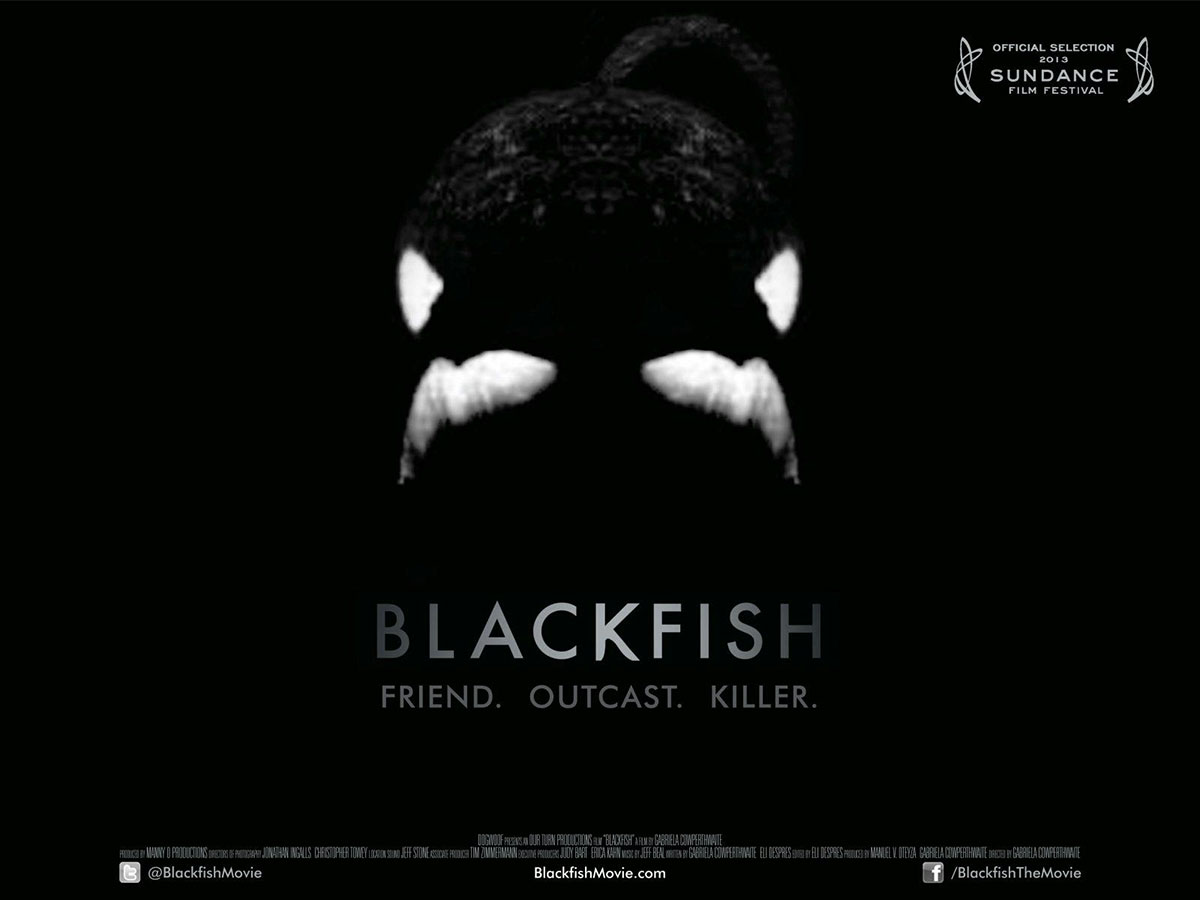
After the release of Blackfish, online petitions began circulating on the internet, urging Southwest Airlines to end their 26-year marketing partnership with SeaWorld. These petitions coincided with Southwest stockholders and passengers publicly voicing their desire that the partnership be terminated. In July of 2014, Southwest announced that they would be severing ties with SeaWorld, and the online petitions were a factor in the decision. In April of 2015, toy maker Mattel announced that its iconic Barbie doll would no longer be produced wearing any SeaWorld outfits, including the orca trainer diving suit.
As a result of the film, New York state legislators proposed legislation that would ban keeping orcas in captivity, California congressmen passed the Orca Welfare and Safety Act, and US congressmen Adam Schiff and Jared Huffman successfully amended the Agriculture Appropriations Act, requiring the United States Department of Agriculture to update the Animal Welfare Act in regards to cetacean captivity. The amendment allocates one million dollars to study the impact of captivity on all marine mammals. Both congressmen Schiff and Huffman cited Blackfish as a motivating force in introducing the amendment.
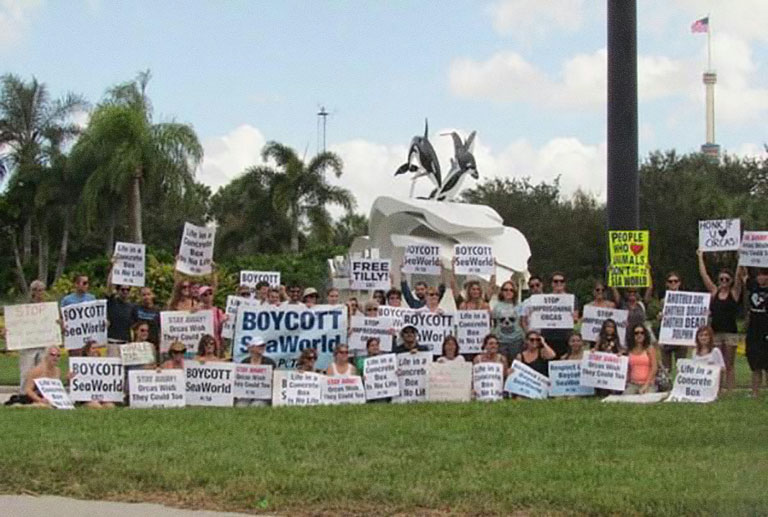
In September 2014, a class action lawsuit was introduced by SeaWorld stockholders against SeaWorld, alleging that SeaWorld misled them concerning the severity of negative publicity that Blackfish has had on SeaWorld stock. Another three lawsuits were levied against SeaWorld in April 2015, claiming SeaWorld was operating under false pretenses and deceiving the public with misleading advertising that overtly implies the orcas in SeaWorld aquariums are happy and thriving.
In response to the overwhelming worldwide pressure, SeaWorld finally announced in March of 2016 that it will phase out its theatrical orca shows at all three of its U.S. parks. The San Diego SeaWorld ended shows in 2017 and the San Antonio and Orlando Sea World’s started phasing out orca shows at the end of 2019. The company also announced that they will stop breeding captive orcas, and house no more orcas at any future SeaWorld parks. However, SeaWorld are still adamantly refusing to retire their current orcas to sea sanctuaries which would allow them to live out the rest of their lives swimming freely in ocean waters. Sadly, despite no longer breeding orcas, SeaWorld is still breeding whales, dolphins and other sea mammals.
Sanctuaries

The Whale Sanctuary Project
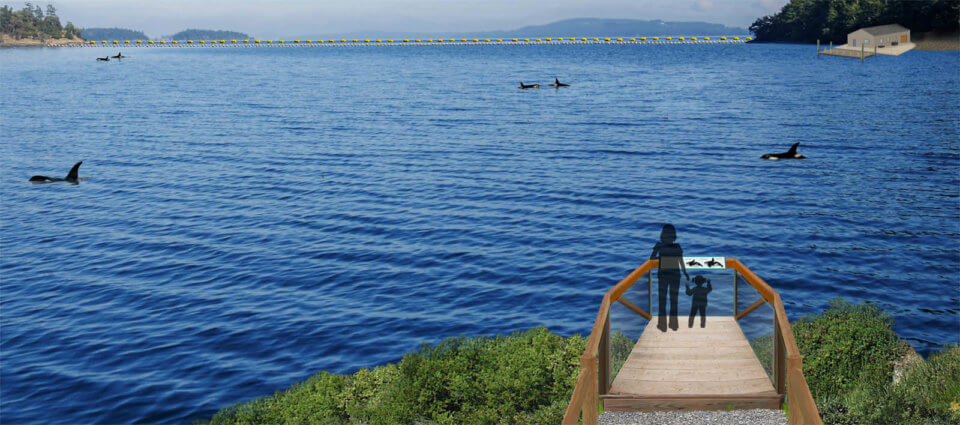
The Whale Sanctuary Project is in the process of creating a massive seaside sanctuary where cetaceans(whales and dolphins) can live in an enviornment that maximizes well-being and autonomy, and is as close as possible to their natural habitat. In February 2020, after two years of researching hundreds of locations on the east and west coasts of North America, they selected Port Hilford, Nova Scotia, as the best site to create the sanctuary. And they have now begun site development. Whale Sanctuary is the first organization focused exclusively on creating seaside sanctuaries in North America for orcas and beluga whales who are being retired from entertainment facilities or have been rescued from the ocean and need rehabilitation or permanent care. See below for a TEDx talk, that Charles Vinick, Executive Director of the Whale Sanctuary Project, did in November 2017. Here he describes what he’s learned over many years about orca and beluga whales, in the wild and in captivity, about who they are and what it’s like for them to be kept in concrete tanks, and about the growing movement to bring an end to having whales on display in marine parks and aquariums.
Bali Dolphin Sanctuary
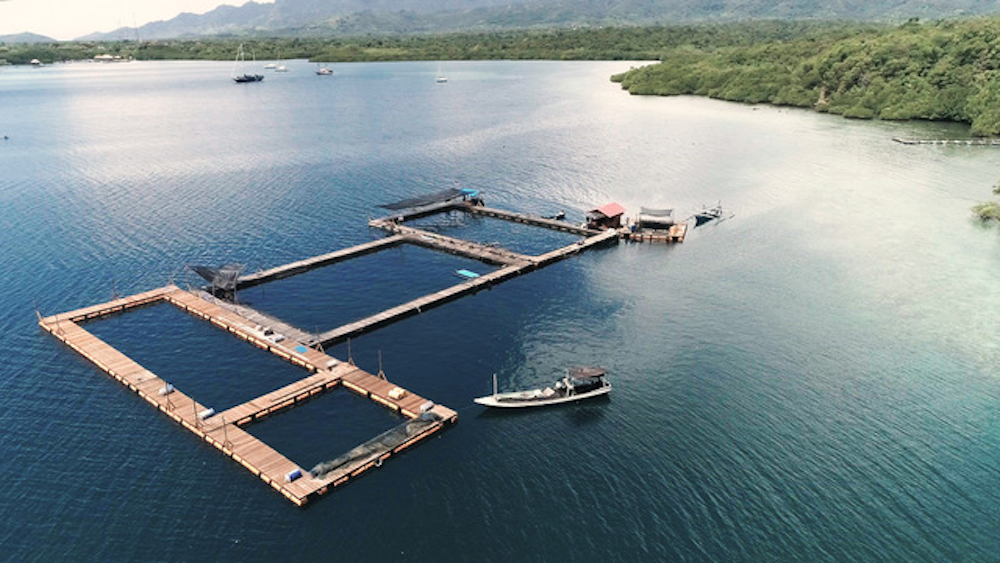
In 2019 Dolphin Project, In conjunction with local partners, the Central Jakarta Forestry Department and the Jakarta Animal Aid Network (JAAN), established the world’s first permanent dolphin sanctuary in Bali, Indonesia. The government granted them permission to build a massive floating sea pen near the mouth of Bajul Bay, located in West Bali National Park where the water is calm and crystal clear.
SEA LIFE TRUST Beluga Whale Sanctuary
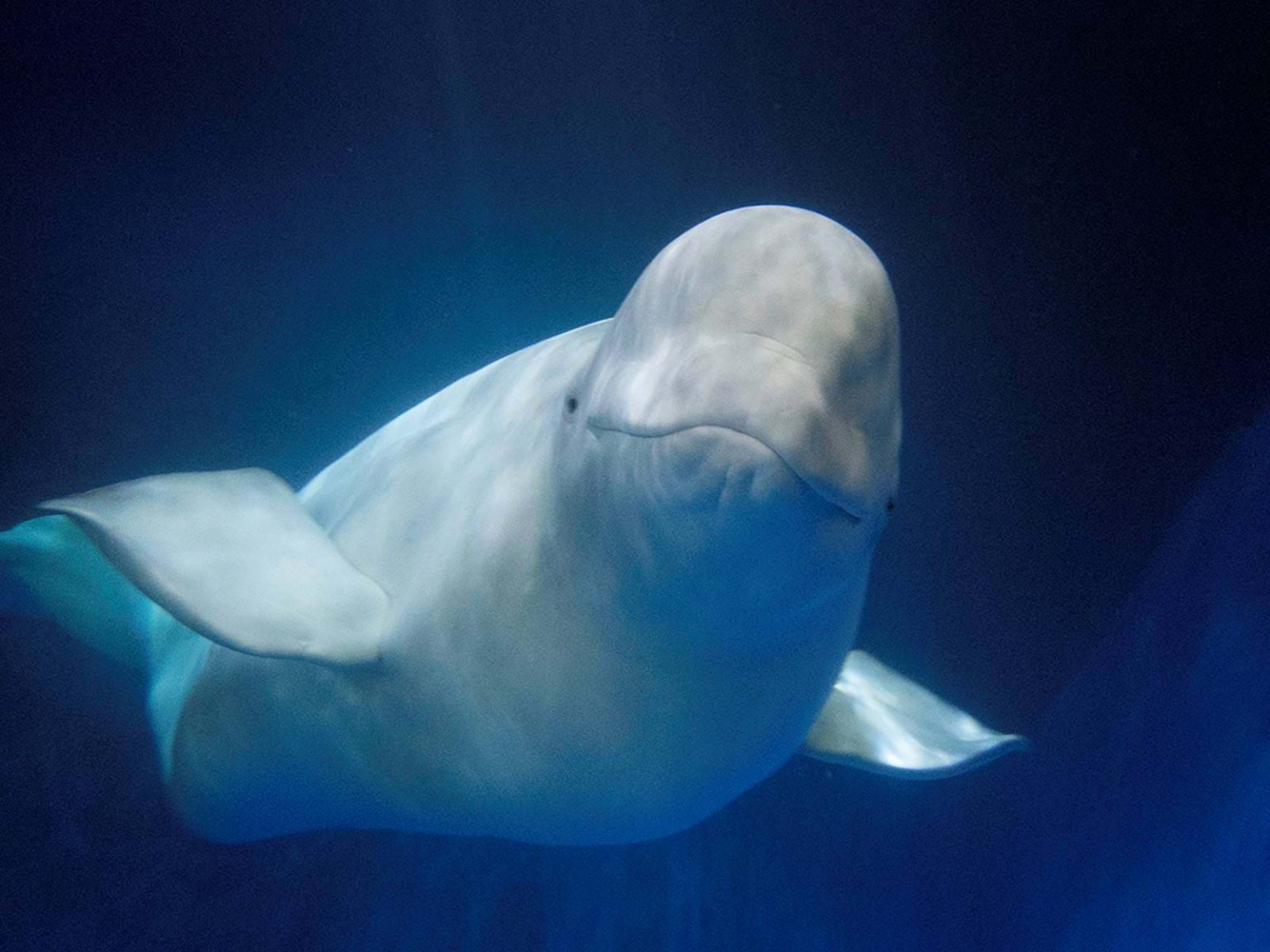
The SEA LIFE TRUST Beluga Whale Sanctuary was created in 2019, in Klettsvik Bay, Iceland. The Sanctuary is owned and run by the SEA LIFE Trust, a registered charity working globally to protect the world’s oceans and the amazing marine life that lives within them. It was created in partnership with Whale and Dolphin Conservation (WDC), and is one of the biggest developments in captive whale and dolphin care & protection ever. The Sanctuary was built with the support of a donation from Merlin Entertainments. And while Merlin’s partner, Sea Life, operates aquariums around the world, the two companies have a longstanding policy of not displaying whales and dolphins at any of their facilities.
The first two residents of the first open-water beluga whale sanctuary in the world, are belugas rescued from an entertainment park in China, Little Grey and Little White. The large bay area, which measures nearly eight acres and has a depth of up to 33 feet, provides plenty of space for the belugas to swim, explore and dive.
Return to the Wild

With proper rehabilitation, some cetaceans are able to fully readapt to life in the wild, even after years in captivity. There are many recorded instances where captive dolphins and orcas have been successfully reintroduced back into their natural habitat. It is a massive challenge though, as many others are better suited for a life in a sanctuary, as they have not learned the necessary survival and socialization skills in captivity that are needed to survive.
A wonderful example of cetacean resiliency is the story of Sampal the dolphin. In 2010, at approximately ten years of age, Sampal was caught in a fishing net in her home waters off the shores of South Korea. She was then sold to the Pacific Land Aquarium in Seoul by the fishing company who had captured her. In her new life at the aquarium, Sampal was forced to learn tricks for food and her home was a tiny pool. For three years she lived in captivity at the aquarium.
In spring of 2013, South Korean animal rights activists, concerned citizens, and Seoul Mayor Park Won-soon convinced the South Korean High Court to order Sampal and two other captive dolphins, Jedol and Chunsam, to be released into open waters. A rehabilitation facility with a temporary sea pen was set up to help the dolphins gradually assimilate back into their natural oceanic habitat. Their release was planned for later that summer, but after four weeks of rehabilitation, Sampal found a small hole in the net and seized the opportunity.
Within a couple of weeks, she was spotted off the shore of the island where she had originally been caught, playing and socializing with her family pod! She had swam over 60 miles alone and found her family, who enthusiastically received her back. Better still, about two months later, Jedol and Chunsam, who had been recently released from the rehabilitation pen, were seen by marine biologists actively swimming and playing with Sampal and the rest of the pod. But the magical story wasn’t over. In April of 2016, the pod was being tracked by a team from two Korean universities when Sampal was observed swimming with a baby calf. Weeks later, the team announced that the evidence was conclusive, the calf was indeed Sampal’s; she had given birth and was a mother!
Increased Public Awareness

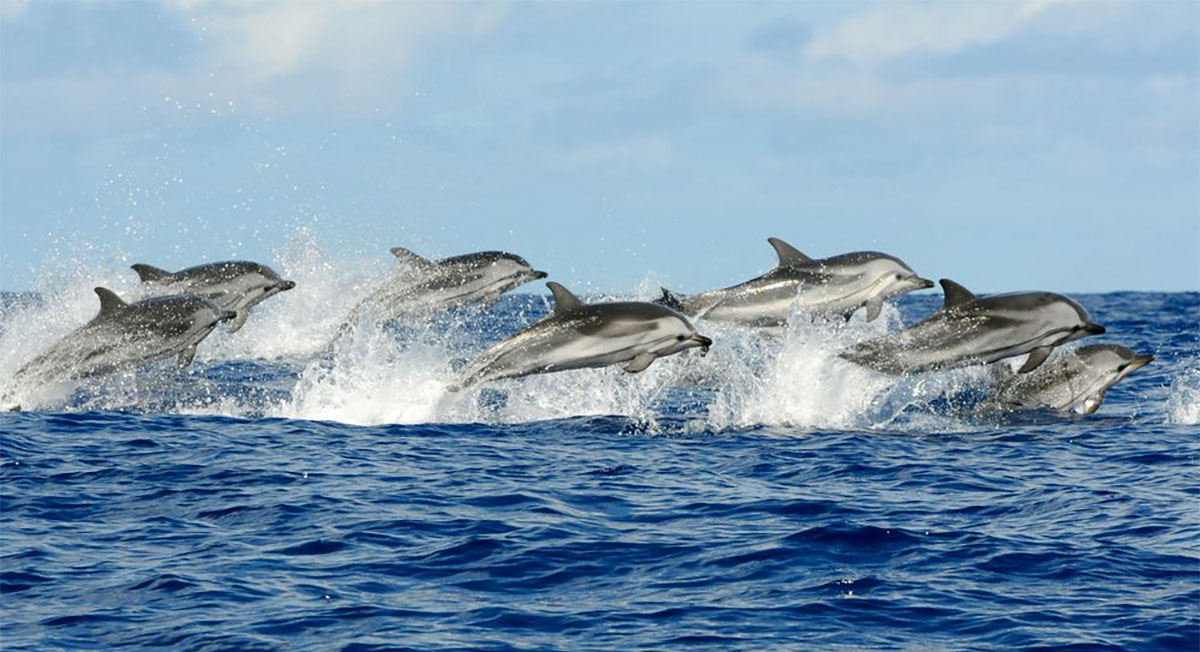
Many orca, dolphin, and whale activists believe major positive change is about to take place concerning the way humans perceive cetacean captivity. Major activist groups like Ric O’Barry’s Save Japan’s Dolphins, Paul Watson’s Sea Shepherd Conservation Society, and the Whale and Dolphin Conservation Society, are reaching unprecedented numbers of concerned people throughout the world, people who are becoming more and more interested in learning about cetacean intelligence and their plight in captivity. The only way to end cetacean captivity is through continued education and increased public outcry. If you would like to support or become involved in making a difference, visit the Explore section of this dream, which features a list of organizations working relentlessly to end cetacean captivity.
The only way to end cetacean captivity is through continued education and increased public outcry
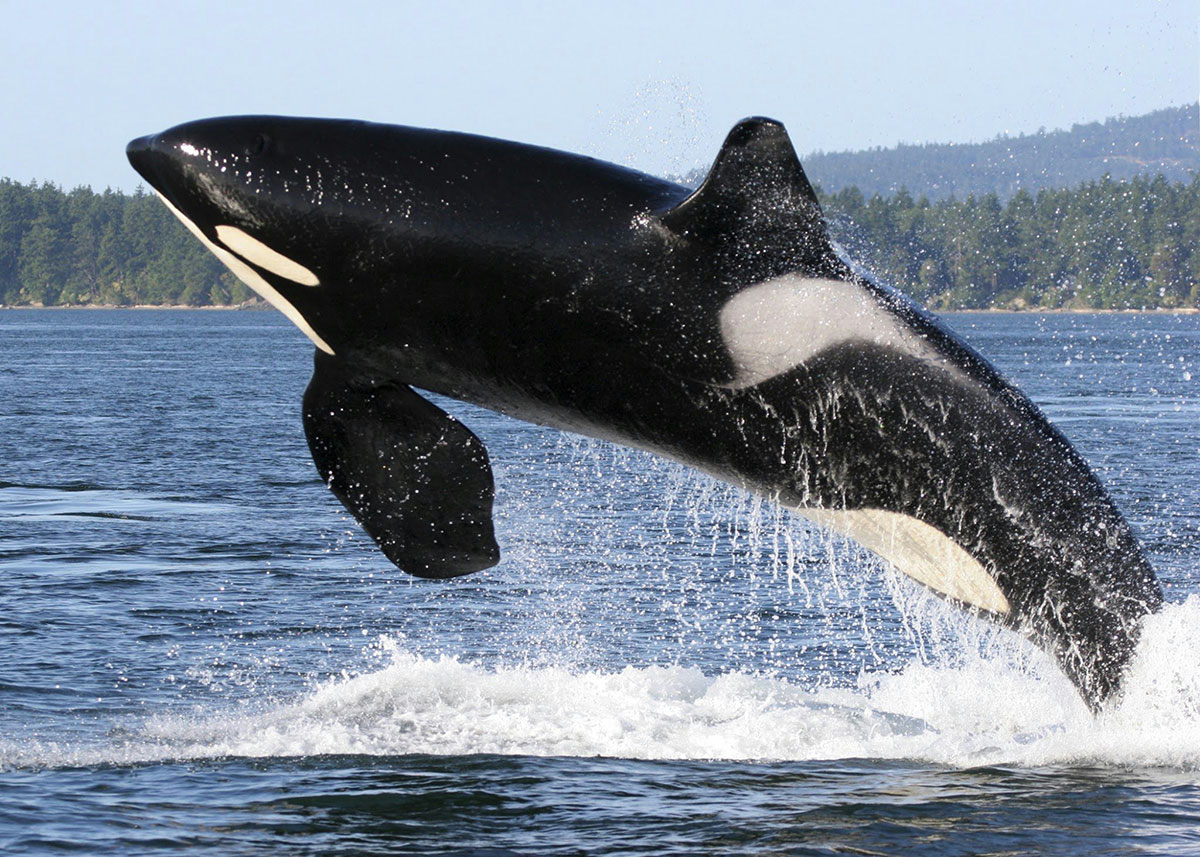
Lolita

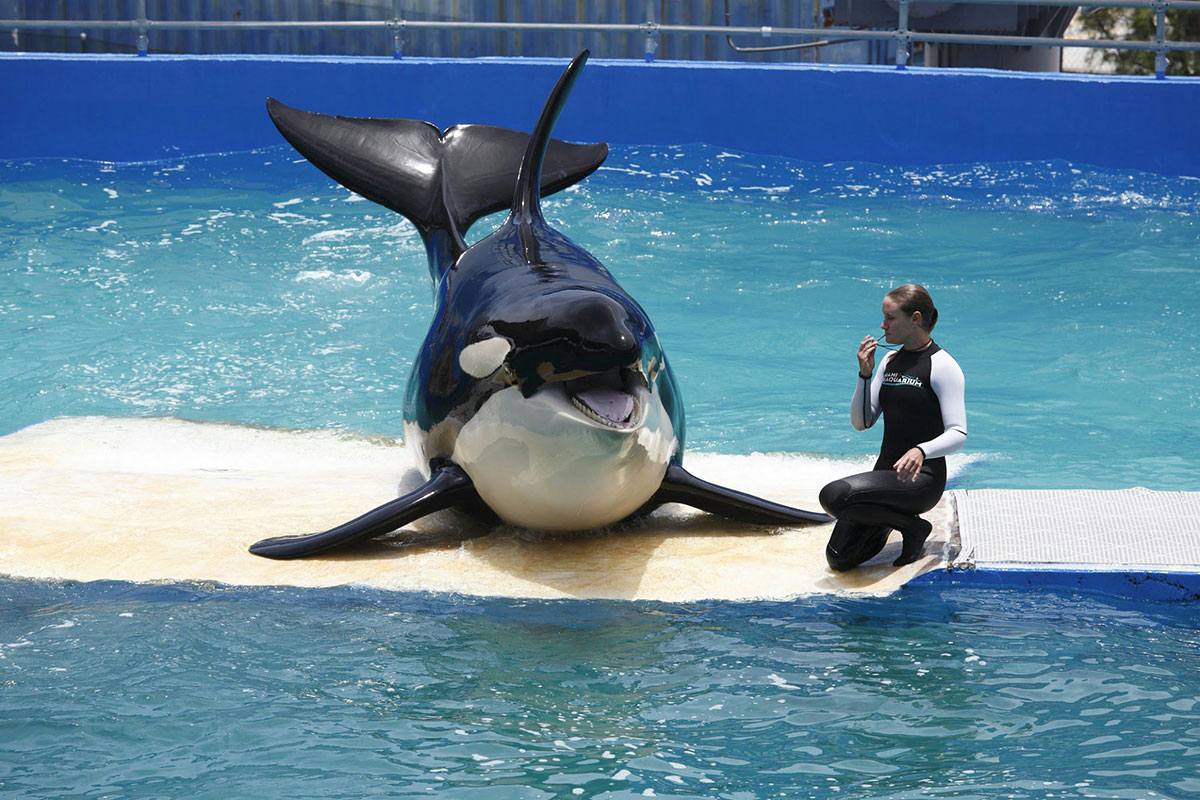
Lolita, who was held in captivity for over 50 years, died in captivity in August 2023. She was known as the “world’s loneliest orca”, and inspired a movement to get her, and all captive Cetaceans freed.
What makes her passing even more tragic, was that after decades of activism, in March 2023, a legal agreement was announced that would have returned her to her family pod in the waters she was taken from in 1970.
Her story, and legacy, are an important reminder of the horrific life these animals endure. When Lolita was three years old, she was torn from her mother’s side and separated from the rest of her family pod off the coast of Washington. She was sold to the Miami Seaquarium that same year and had been confined there for over 50 years. Initially, she had the companionship of Hugo, a male orca also captured off the coast of Washington. However, Hugo died in 1980 by committing suicide, repeatedly ramming his head into the side of the pool at the seaquarium. Lolita was kept alone ever since. Not only was she housed in a tank that violated the USDA’s standards for minimum size, but she was also kept in solitary confinement that had provided no shelter from the hot Florida sun and extreme weather conditions.
Animal rights advocates had been campaigning for her release for decades, as her mother and family members still live in the area she was taken from, but for years the Miami Seaquarium refused to release her. In early 2015, a petition demanding the release of Lolita, addressed to the USDA Administer of Animal and Plant Health Inspection Service, Devin Shea, received more than a quarter of a million signatures. In May of 2015, the National Oceanic and Atmospheric Administration (NOAA) determined that Lolita was to be included in the Endangered Species Act (ESA) listing along with the rest of the Southern Resident Orca population, which had already been included in 2005. Prior to this determination by the NOAA, Lolita was the only captive member of any endangered species to be excluded from the ESA listing. Her inclusion in the ESA gave animal rights groups the legal ground to sue the Seaquarium. In July of 2015, a coalition of animal rights organizations including the Animal Defense Legal Fund (ALDF), People for the Ethical Treatment of Animals (PETA), and Orca Network filed a lawsuit against the Seaquarium, arguing that as a member of an endangered species, it was illegal to force Lolita to perform and keep her in unnatural conditions which are prohibited under the Endangered Species Act.
In August of 2015, the mayor of Miami Beach, Philip Levine, publicly demanded that Lolita be released, saying “Miami should be known as the beautiful, modern city that it is — not as the home of the smallest orca tank in North America. This endangered animal must be released as soon as possible from the appalling conditions at the Seaquarium and moved to a sanctuary in her home waters.” In May of 2016, ALDF, PETA, and Orca Network again filed a lawsuit, this time against the USDA, for granting the Miami Seaquarium’s new owner (a large California entertainment corporation) a permit allowing Lolita to remain in captivity. The permit was granted by the USDA even though the new company could not show that Lolita was being held in sufficiently adequate living conditions as mandated by the USDA’s own regulations.
Finally, after all of these intense legal battles, in March 2023 it was announced she would be returned to her home waters by Eduardo Albor, the CEO of the Dolphin Company, and Indianapolis Colts owner Jim Irsay, and environmentalist Pritam Singh. The entire process would have taken from 6 months to 2 years, and was amazing news and a huge victory for Lolita, and all her supporters, but unfortunately she did not make it.
Her memory and story though, will continue to inspire activism until all captive Cateceans are freed. In fact in March 2024, seven months after her passing, it was announced that the lease for the Miami Seaquarium was not renewed after decades of animal rights activism on Lolita’s behalf. According to Miami Mayor Daniella Levine Cava, “The Seaquarium has a long and troubling history of repeated, continuous violations of their contractual obligations to keep the property in a good state of repair, maintain animal welfare in accordance with applicable laws, and to comply with the lease,”

Action
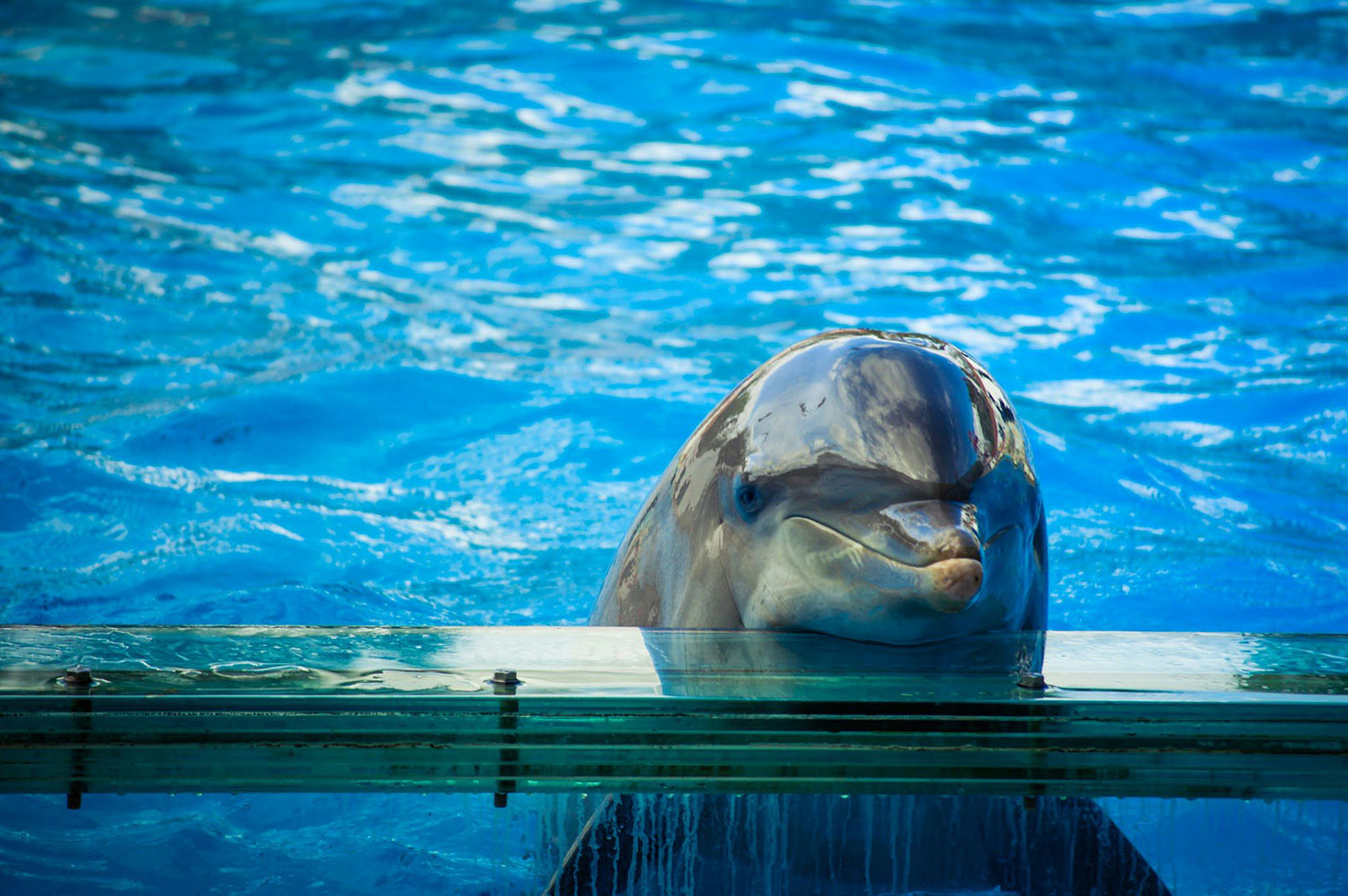
Cetacean captivity exists all over the world. Whether in massive marine theme parks like SeaWorld, official state-run aquariums, or a small swim-with-dolphins tourist attractions at seaside resorts, the captive dolphins, orcas, and whales in these facilities are held against their will. By standing up and making your voice heard, you become an important part of a worldwide effort to end cetacean captivity once and for all. Here are some effective ways you can take action:
Do not visit marine water parks or any facility that keeps captive cetaceans

One of the easiest and most effective ways to end the captivity of dolphins, orcas, and whales is to simply avoid the places that keep them in captivity. The Taiju fishermaen can sell captured dolphins and orcas for hundreds of thousands of dollars only because the theme parks and aquarium’s that buy them make tens of millions of dollars from ticket sales. Since Blackfish came out, attendance at Sea World has plummeted and their stock has plummeted with it. Many students around the United States have successfully convinced their schools to discontinue all field trips to Sea World or any facility that keeps captive cetaceans. The effectiveness of simply not going to these captive facilities cannot be overstated.
Many students around the United States have successfully convinced their schools to discontinue all field trips to Sea World
SUPPORT THE ‘SWIMS ACT’

Please ask members of Congress to co-sponsor the SWIMS Act, and support organizations like The Oceanic Preservation Society, to help pass this important piece of legislation.
The Strengthening Welfare in Marine Settings (SWIMS) Act (H.R. 7145/S. 3694) will end the future capture, exploitation and breeding of orcas, beluga whales, pilot whales, and false killer whales in the United States. It also prohibits importation and exportation of these whales, and provides exemptions for animals being transported to a sanctuary setting or released to the wild.
The act will essentially begin to phase out the ability to keep any of these species in captivity for public display.
Free Morgan Campaign

Morgan is a young female orca who was captured off the coast of the Netherlands in June 2010 at age three. At the time of her capture she was emaciated and in distress. She was rescued and transferred to the smallest captive dolphin tank in the world, located at Dolfinarium Harderwijk, under a ‘Rescue, Rehabilitation and Release’ permit. Despite making a full recovery, Morgan has remained in captivity ever since. She was moved to a marine theme park, Loro Parque Spain, in November 2011 and lives in very cramped conditions. Although the facility permit explicitly prohibits the public display of Morgan, she is forced to perform for the public daily. Furthermore Morgan has repeatedly been attacked by the other older orcas at Loro Parque, who are on loan from Sea World and who all come from different pods.. It has been documented that Morgan has suffered over 600 bites. She, also, shows severe abnormal and repetitive behaviors, including self-inflicted damage to the tip of her snout and lower jaw from repeatedly banging her head on the sides of the concrete tank. Photographic evidence indicates that she has ground some of her teeth down to the gums and continues to damage her other teeth as a result of stress and boredom.
Footage from Loro Parque captured by an anonymous activist in April of 2016 showed Morgan repeatedly slamming her head against a metal gate separating two small pools, clearly expressing distress and frustration with her surroundings. Additional footage captured a month later revealed Morgan purposely beaching herself on the concrete slab next to the pool she was performing in, lying motionless for ten minutes. Deliberately staying out water for minutes on end isn’t normal orca behavior. Orcas in the wild remain constantly in motion, even swimming while sleeping.
The Free Morgan Foundation, led by Dr. Ingrid Visser, and other organizations including the Born Free Foundation, are actively seeking the release of Morgan into a rehabilitation sea pen and, ultimately, her release back to the wild to be reunited with members of her family pod. Numerous marine biologists, including Dr. Visser, have noted that Morgan’s situation is very similar to that of Springer’s, who was successfully released back to the wild. Please support the Free Morgan Foundation.
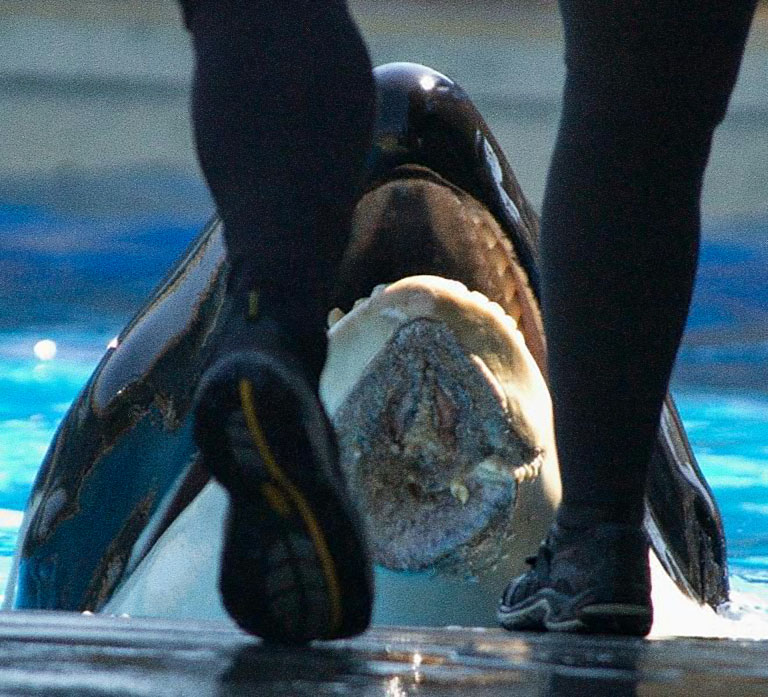
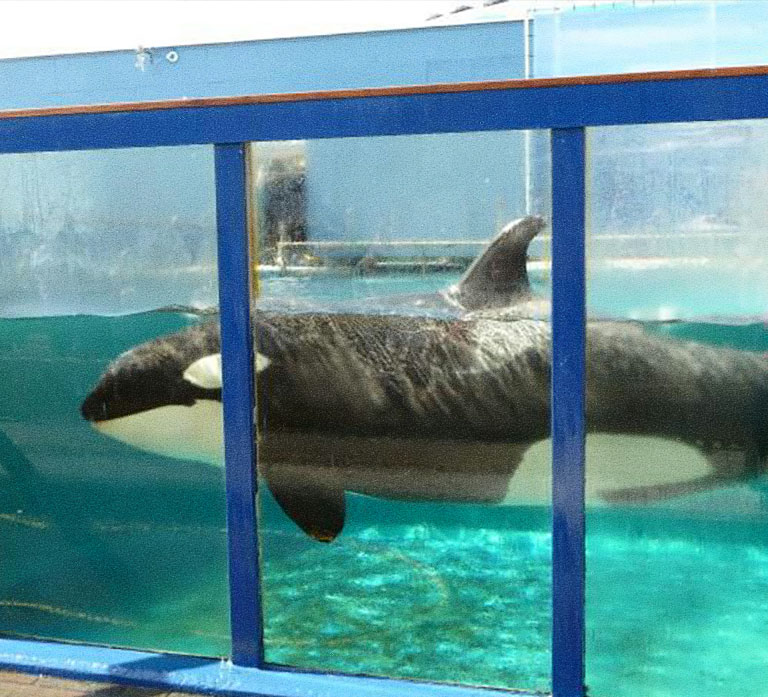
EMPTY THE TANKS – EVENT

The Dolphin Project created the ‘Empty The Tanks” Event in 2013, after they witnessed the direct link between dolphin captures, slaughter and the captivity industry. It is an annual peaceful protest that takes place in 64 different aquariums and marine parks, in 20 different countries. It has expanded into a global movement.
For more information go to emptythetanks.org/worldwideevent

Don’t support companies associated with the captive cetacean industry

You can also make a difference in ending cetacean captivity by not supporting companies that are associated with marine parks and aquariums.For example, Asiana and Korean Airlines transport captive cetaceans captured at Taiji to aquariums all over the world. Choose not to fly either airline or call them and express your concerns. United Airlines stopped transporting cetaceans in October 2014 in response to public pressure. Your voice makes a difference.
Contact Your Elected Officials

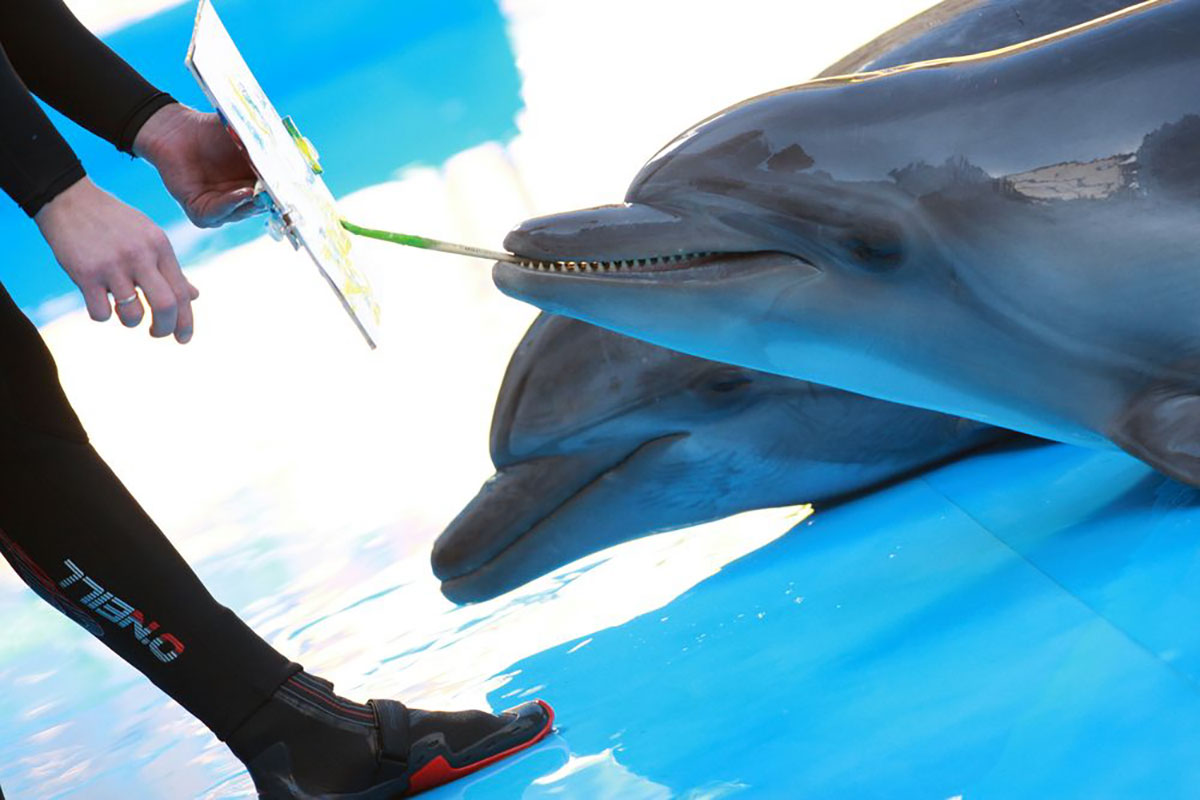
Even if your city or region doesn’t have a marine park or aquarium, urge your elected officials to ban the display of captive cetaceans in your city, district, and state. In 1982, the relentless work of activist Mark Berman helped pass the first and only U.S. state law banning cetacean captivity in South Carolina. The tireless work of everyday activists around the world have led to the banning of cetacean captivity in 14 countries, including Costa Rica, Greece, Switzerland, and India. To find your elected state and local officials, visit congress.org and type in your zip code. If you live in New York, contact your state senator and ask him or her to support Senate Bill 6613, which would ban the possession and display of orcas in all New York State aquariums and sea parks. To find your New York senator, click here.
The tireless work of everyday activists around the world have led to the banning of cetacean captivity in 14 countries
Post Information About Cetacean Captivity on Facebook and Other Social Media Sites

Most all cetacean advocacy organizations have Facebook and Twitter accounts. Follow their pages and share photos and posts with your friends and family. Many cetacean advocacy groups believe a dramatic shift in the way the world’s population views cetacean captivity is fully underway. This momentum is a result of people educating themselves, their family, and their friends about the sad reality of cetacean captivity and the intelligence of these animals. Much of this education comes from concerned individuals posting on social media sites. In one effective Facebook campaign users posted pictures of themselves in a bathtub with a sign saying “Could you live your life in a bathtub?”.
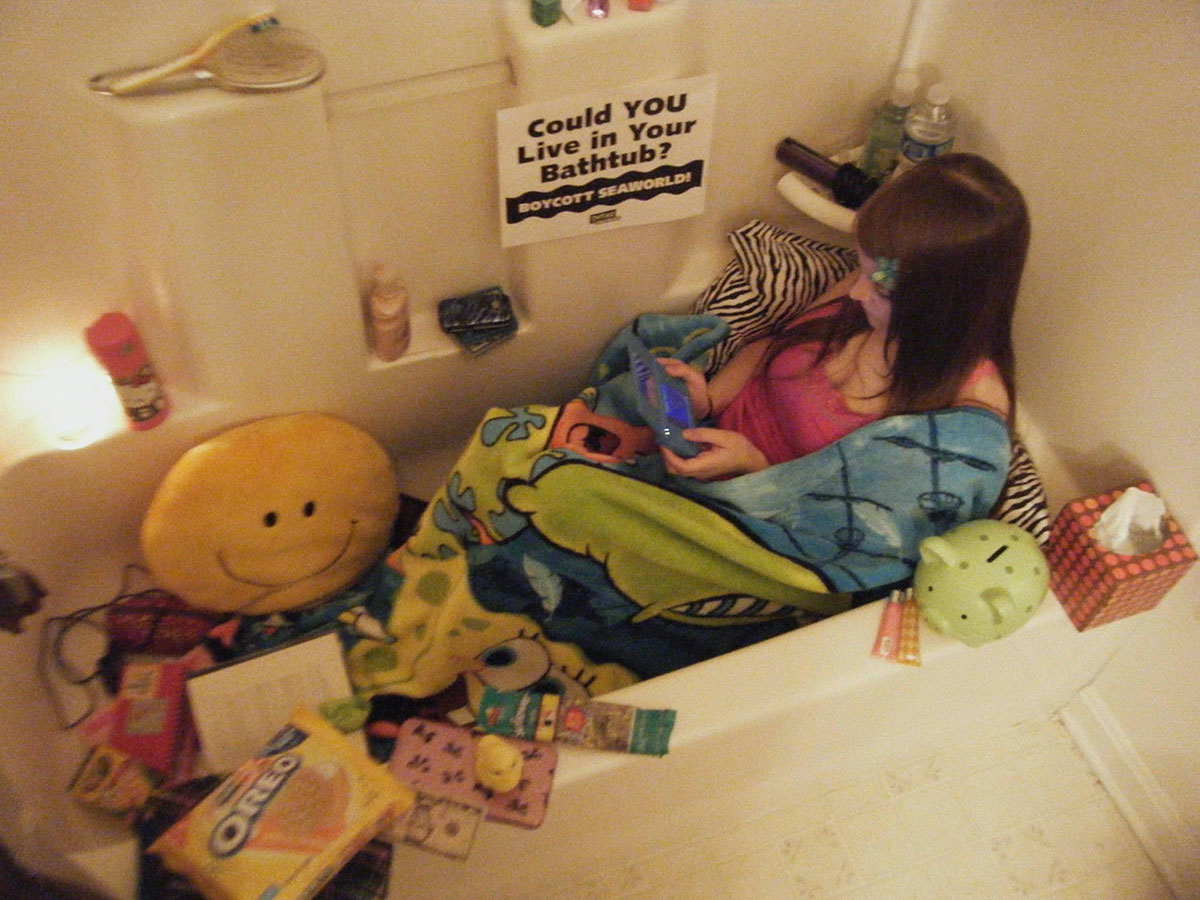
Support Cetacean Advocacy Organizations

The Whale Sanctuary Project

The Whale Sanctuary Project is in the process of creating a massive seaside sanctuary where cetaceans(whales and dolphins) can live in an enviornment that maximizes well-being and autonomy, and is as close as possible to their natural habitat. In February 2020, after two years of researching hundreds of locations on the east and west coasts of North America, they selected Port Hilford, Nova Scotia, as the best site to create the sanctuary. And they have now begun site development. Whale Sanctuary is the first organization focused exclusively on creating seaside sanctuaries in North America for orcas and beluga whales who are being retired from entertainment facilities or have been rescued from the ocean and need rehabilitation or permanent care. See below for a TEDx talk, that Charles Vinick, Executive Director of the Whale Sanctuary Project, did in November 2017. Here he describes what he’s learned over many years about orca and beluga whales, in the wild and in captivity, about who they are and what it’s like for them to be kept in concrete tanks, and about the growing movement to bring an end to having whales on display in marine parks and aquariums.
Sea Shepherd
Sea Shepherd is one of the world’s most recognized and effective dolphin, orca, and whale advocacy organizations, working at the international, regional and local levels for an end to the exploitation of cetaceans. Sea Shepherd uses direct action tactics to protect all forms of marine life all over the globe. The organization, founded in 1977 by Paul Watson, focuses on educating people about the negative impact humans have had on the oceans. In 2008, Animal Planet began filming the weekly series, Whale Wars based on the Sea Shepherd’s confrontations with the Japanese whaling fleet. This series has exposed millions of viewers to Sea Shepherd’s conservation work, as well as to the horrors of the whaling industry. Sea Shepherd has received massive support from millions of people around the world for its ongoing efforts against cetacean capture and captivity, seal hunting, marine fishing and oceanic pollution. Supporters include many celebrities, such as Christian Bale, Daryl Hannah, Emily Deschanel, Pierce Brosnan, Brigitte Bardot, Sam Simon, Sean Penn, and Sean Connery, to name a few.
For a more detailed look at the tireless work Sea Shepherd does for dolphins, orcas, whales, and all marine life, check out their webpage. Sea Shepherd depends upon donor support for their ongoing advocacy and rescue efforts. Supporting Sea Shepherd financially is one of the most practical ways to help put an end to cetacean captivity. There are, also, many volunteering opportunities with Sea Shepherd. Click here to learn more.
Sea Shepherd uses direct action tactics to protect all forms of marine life all over the globe
Ric O’Barry’s Dolphin Project
Ric O’Barry founded the Dolphin Project in 1970 with the goal of ending dolphin slaughter and exploitation around the world. His tireless work in exposing the annual Taiji Dolphin Slaughter in Taiji, Japan was chronicled in the Oscarwinning documentary The Cove, and in the Animal Planet miniseries “Blood Dolphin$.” Ric educates the public concerning the harmful effects of captivity on dolphins through lectures, conferences, and appearances around the world. Visit the Ric O’Barry Dolphin Project website to see how you can help support their important work. To donate to the Ric O’Barry Dolphin Project, visit this link.
Other wonderful cetacean advocacy organizations are working hard to end dolphin, orca, and whale captivity and slaughter. Save Japan Dolphins and The Orca Network are just a couple of the many organizations along with Sea Shepherd and the Ric O’Barry’s The Dolphin Project working tirelessly on behalf of all captive and wild dolphins, orcas, and whales. All of these groups are driven by donor support and have many opportunities for volunteers to actively be a part of their work.
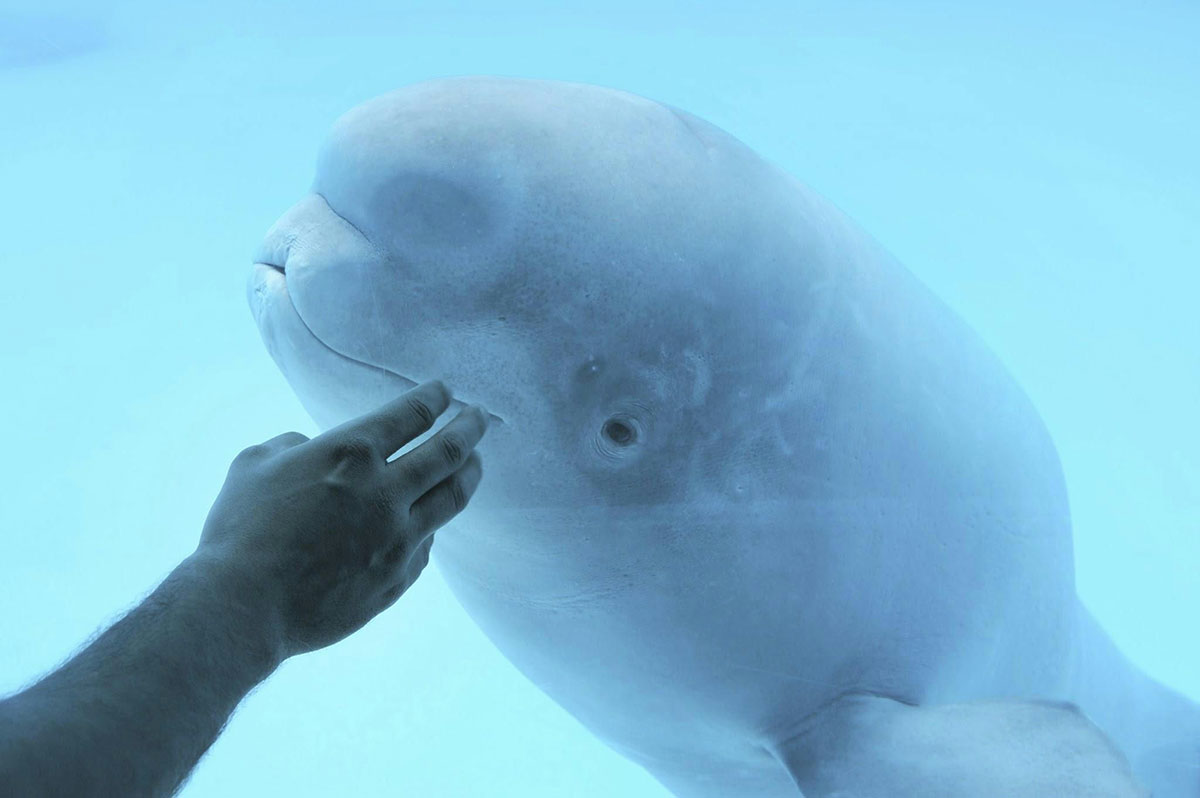

Facts
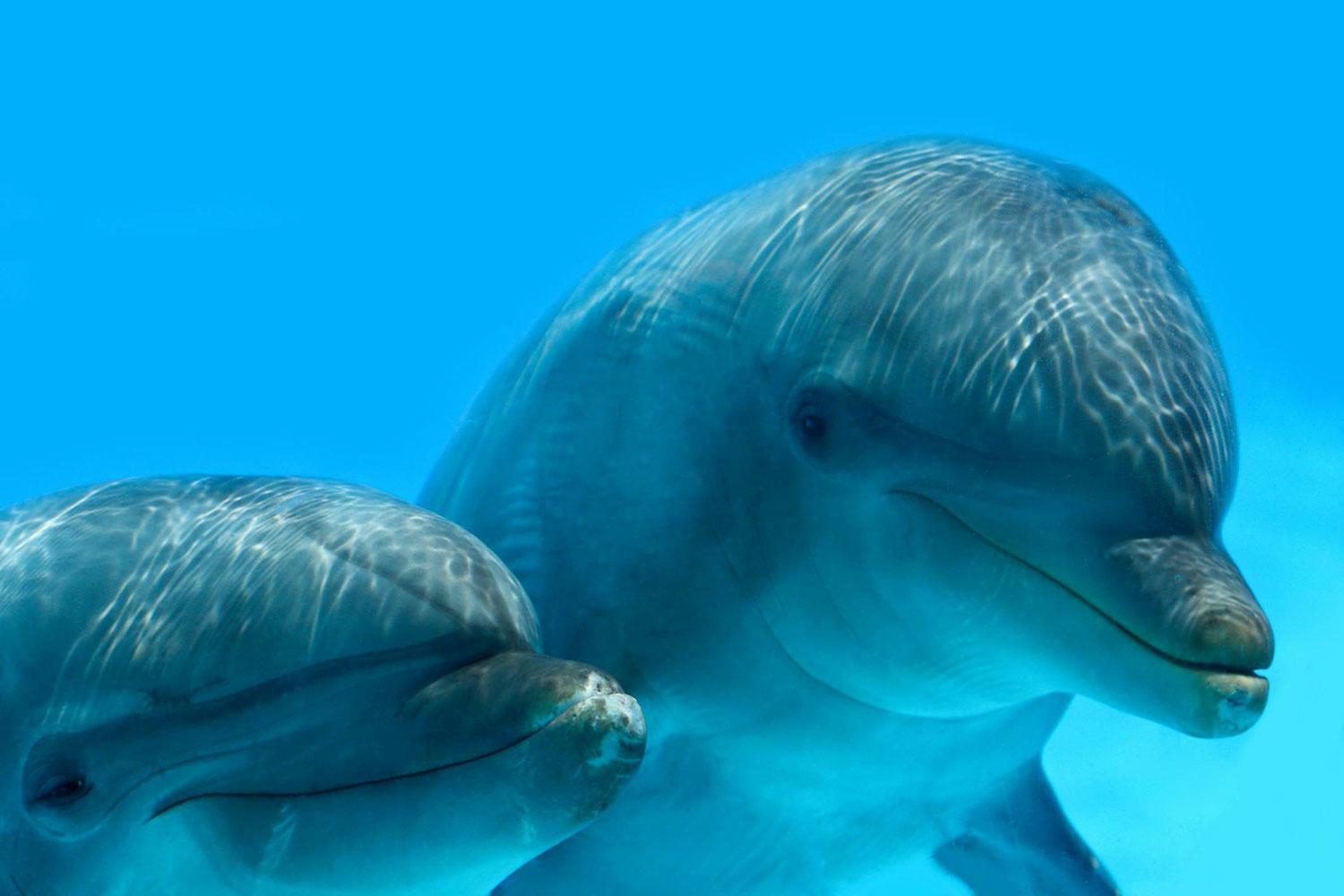
Oceanic dolphins, pilot whales, and orcas (killer whales) are highly intelligent marine mammals that are found throughout the earth’s oceans. Most dolphin species live in shallow areas of tropical and temperate oceans, along continental shelves. Orcas and pilot whales are found in all the earth’s oceans, but are most common in the Arctic and Antarctic. Contrary to popular belief, orcas and pilot whales are not whales, they are very large dolphins. Thousands of dolphins, whales, and orcas are currently held in captivity in zoos, aquariums, and water parks around the world.
These intelligent animals are extremely social and swim in pods, complex social units as small as five members and as large as a thousand or more. Each pod travels and feeds over a range of hundreds of square miles. Some dolphin pods have a loose social structure with individual dolphins frequently joining or leaving, while other pods are permanent, comprised of immediate family members. These tighter family pods are multigenerational and are led by females. It is common for as many as four generations of orcas to exist in an orca family pod. Many marine biologists consider orca pod societies as complex as human societies.
Mature male dolphins develop a lifelong friendship called a “pairbond” with another adult male. The two males feed, seek female mates, and travel between pods together for the duration of their lives. Should a dolphin male’s pairbond die, he will try to pair up with another male who has lost his pairbond.
Vocal communication among dolphins, orcas, and whales is very complex, comprising of lowfrequency whistles, highfrequency clicks, and pulsed calls. The vocalizations of each orca pod have a unique dialect and are different from those of any other orca pod. Every dolphin develops its own individual whistle following birth, which remains unchanged for life. Many marine biologists argue that these individual dolphin whistles, or “names”, provide evidence that dolphins possess selfawareness the capacity to have a concept of “self” and to perceive that one exists as an individual being. Scientists have also recently discovered that dolphins have highly developed spoken languages and converse in the same way as humans. They even noted that dolphins appear not to interrupt one another during conversations.
Dolphins, orcas, and whales use echolocation bouncing sound off objects to determine their location to perceive their underwater surroundings and to aid in hunting prey. Manmade sounds in the ocean interfere with cetacean echolocation, causing hearing loss, disorientation, and brain hemorrhages and have led to thousands of dolphin, orca, and whale deaths. These manmade sounds include acoustic testing, offshore drilling and naval sonar used by submarines.
The natural lifespan of a female orca in the wild is estimated to be 60-80 years but some live upwards of 90 years. One female orca, named Granny by marine researchers, lives most of the year off the coast of Washington state and British Columbia and is estimated to be 105 years old. She swims in a pod with about 25 other orcas, including her children, grandchildren and great grandchildren. The pod has been known to swim over 800 miles in one week. Granny was spotted as recently as August of 2016, swimming with her family. The natural lifespan of orcas in captivity, on the other hand, is less than 25 years. Most captive dolphins, orcas, and whales develop problems associated with Post Traumatic Stress Disorder (PTSD), such as abnormal repetitive behavior, increased aggression and reduced life expectancy. Mortality rates for captive cetaceans in zoos, aquariums, and water parks are much higher than in the wild and reproductive rates are much lower.
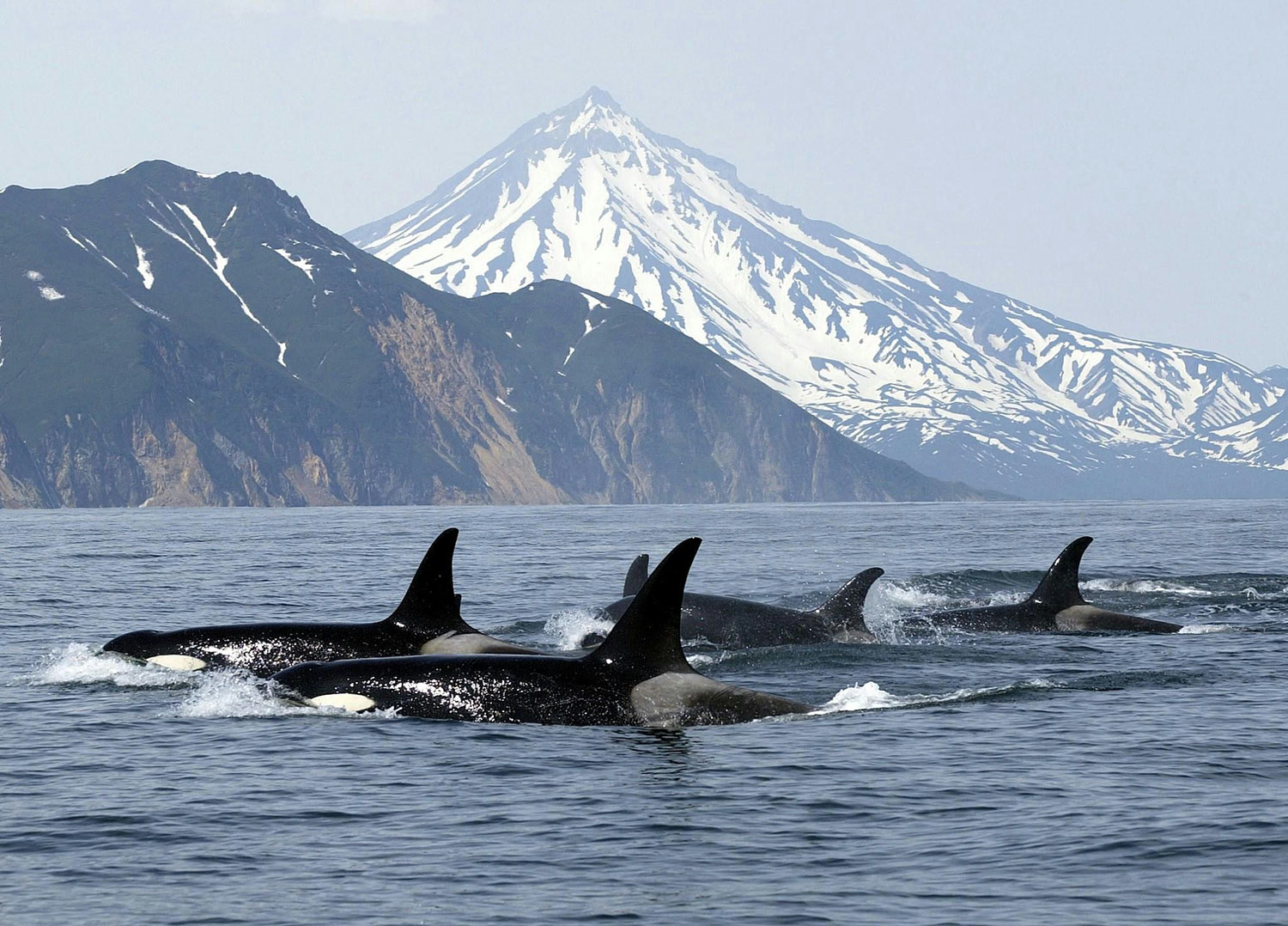

Explore
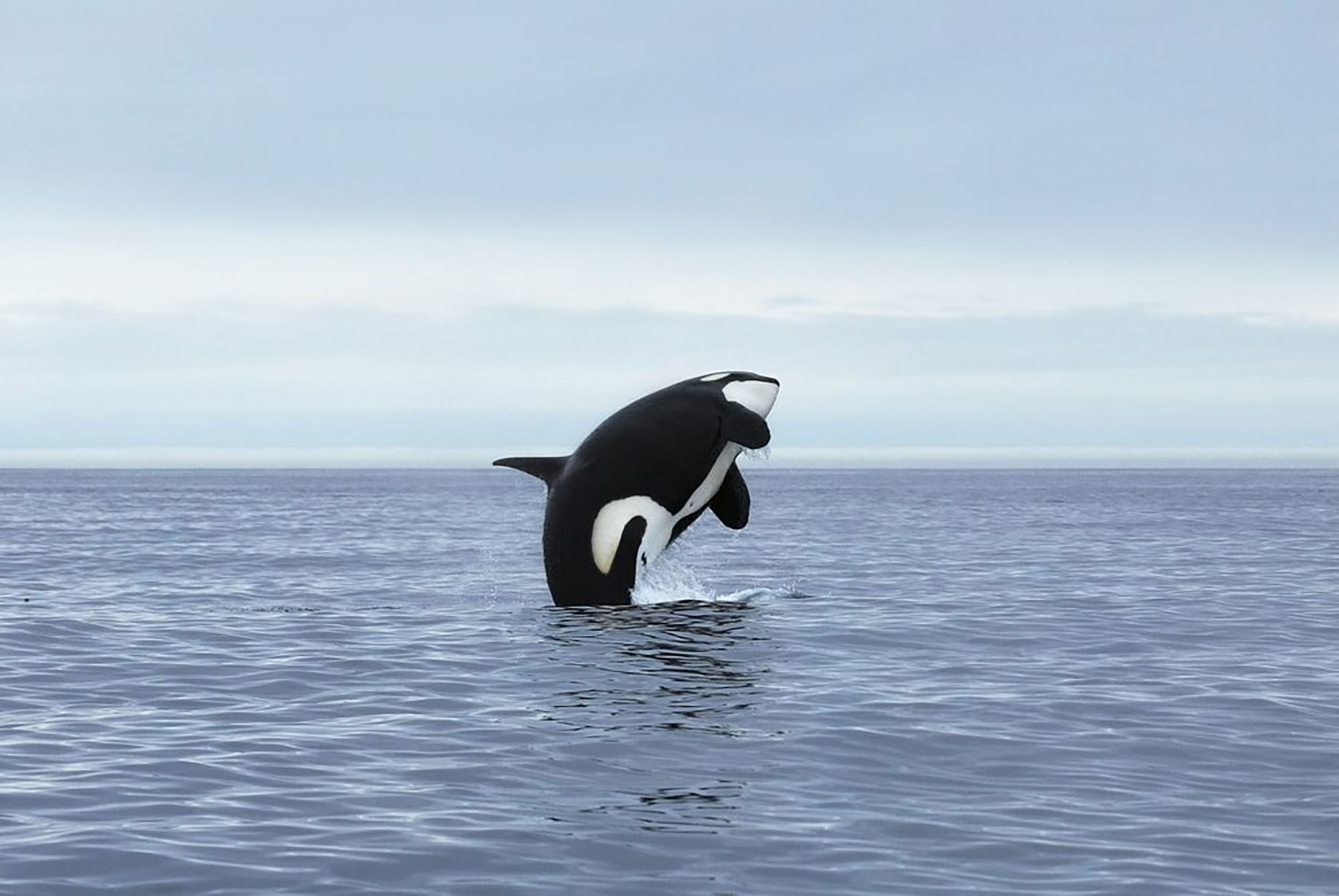
Dolphins, orcas, and whales are considered to be among the smartest animals on earth. They exhibit a wide range of fascinating behaviors that are remarkably human. They communicate using different languages, possess memories that stretch over an entire lifetime, develop life long friendships, are renowned for their love of play, and have incredibly complex social pod structures.
See

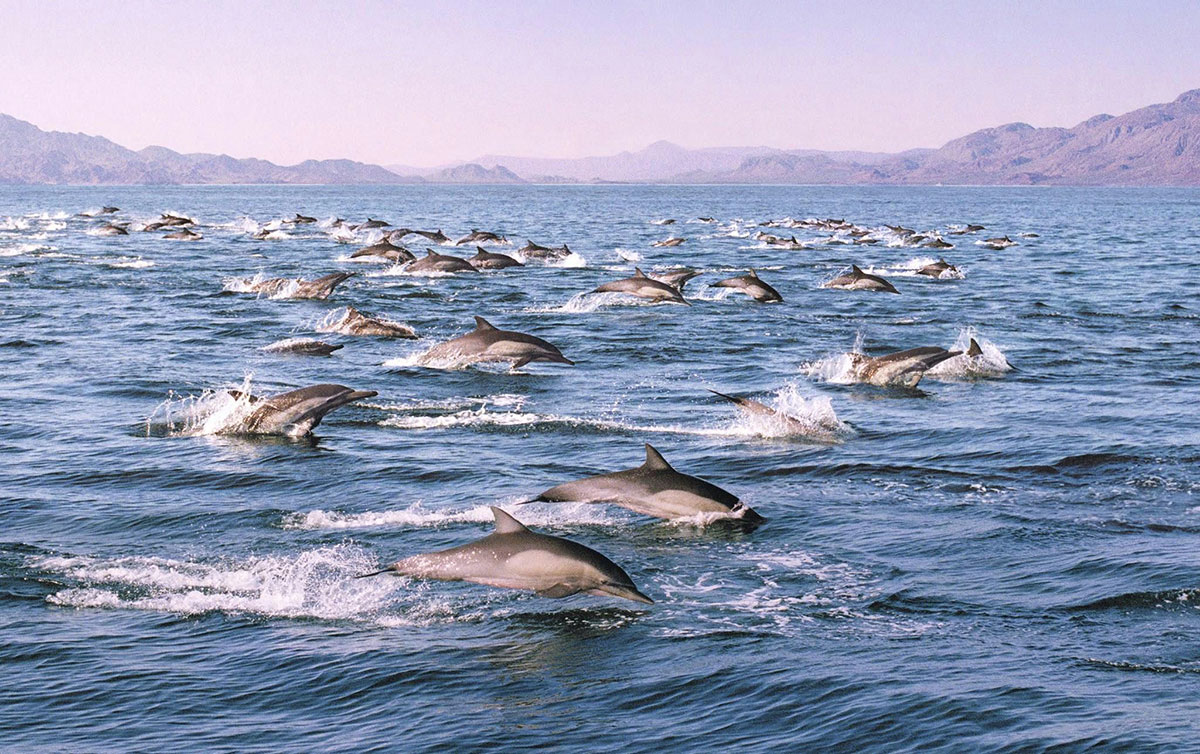
Beauty in Motion
Watch this pod of Pacific White Sided dolphins effortlessly glide around one another as they hitch a ride beside a fast-moving boat off the coast of Santa Cruz, California.
Dolphins to the Rescue
Lifeguard Rob Howes was swimming about 300 feet off a New Zealand beach with three female lifeguards, including his 15year old daughter, when a group of nearby dolphins suddenly began frantically splashing and swimming in circles around them, corralling them into a tight enclosure. Before long, Howes saw a great white shark swimming no more than six feet away from the group. The dolphins continued the defensive maneuvering for 40 minutes, when a rescue boat finally approached the group and the shark swam away. Howes is sure that the shark would have attacked had the dolphins not intervened.
In this amazing video, you can actually see a dolphin driving away a shark who is about to attack a swimmer.
Joyride
A woman wakeboarding gets the ride of her life as a pod of dolphins decide to escort her.
Surfs Up!
Watch this amazing footage of a pod of dolphins surfing on the waves near San Diego.
Interspecies Communication
Like other animals, cetaceans communicate with species other than their own. This amazing video shows a dolphin with a fishing hook embedded in his pectoral fin swimming up to a diver and gently “asking” him to remove it.
Listen

Whales, orcas, and dolphins are extremely intelligent creatures that are accustomed to constant stimulation in their ocean environments. Captive pools can in no way come close to replicating what a cetacean would experience in the wild. NOC the beluga (white) whale was captured in 1977 off the Canadian Pacific coast at only one year of age. He spent the rest of his life in a pool at the US Marine Mammal Foundation in San Diego, California with a group of dolphins and two other beluga whales. To stave off boredom, NOC entertained himself by developing a unique trick: he began mimicking the voices of his human trainers. He even learned how to say the word “out” which he would say when the trainers were in the pool with him. Beluga whales communicate with vocalizations that are octaves above the human voice, but NOC devised a way of altering the pressure in his nose and blowing air through in distinct pulses to create vocalizations that sounded just like a human voice. Listen to NOC’s amazing vocalizations by following this link. Beluga whales live between 35 to 50 years in the wild, some have even lived as long as 80 years. NOC died in captivity in 2007, at age 31.
To stave off boredom, NOC entertained himself by developing a unique trick: he began mimicking the voices of his human trainers
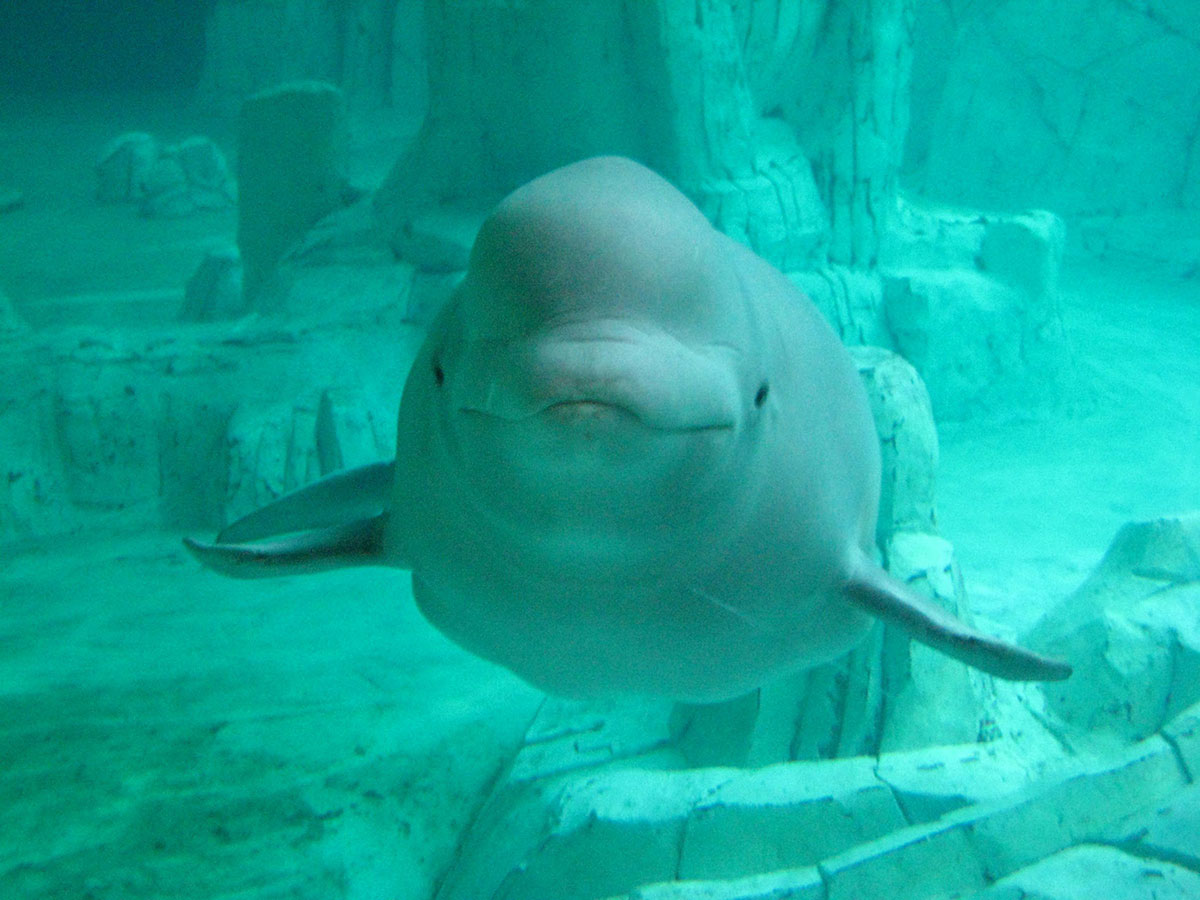
Orca vocalizations
In this amazing video, listen to a of pod orcas off the Pacific coast of Washington communicating with one another using high pitched calls, clicks, and whistles.
Interact

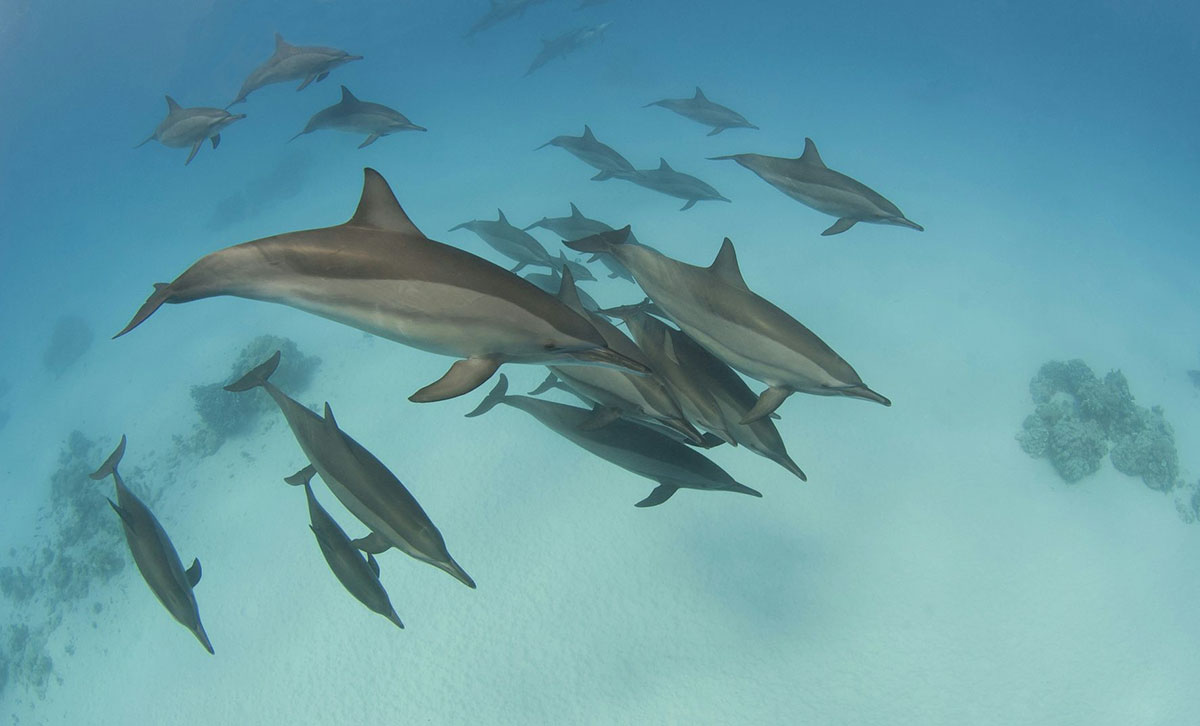
There are numerous organizations working throughout the world to end dolphin, orca, and whale captivity. Many, like Sea Shepherd and Ric O’Barry’s The Dolphin Project are global organizations that are on the front lines of ending the exploitation of these extremely intelligent animals. You can be an active part of the movement by supporting these groups. In doing so, you will become an integral part of the global effort to end cetacean captivity. Also, through social media, you can become friends and connect with other dolphin, orca, and whale activists from around the world. Most cetacean advocacy groups have social media accounts on Facebook and Twitter. The links for the for these organizations are listed here, as well as a link to their websites. Get involved!
You can be an active part of the movement by supporting these groups
Dolphin and Orca Advocacy Groups
Learn

The Sea Shepherd webpage is a treasure trove of educational information about orcas, whales, and dolphins and the movement to end cetacean captivity. The site features countless videos and photos and much information about the history of these majestic creatures, the history of cetacean captivity, and the current effort to end cetacean exploitation around the globe. It is a fantastic resource for anyone researching or wanting to make a difference concerning this issue.
Another fantastic site that has an entire page with over thirty videos devoted to dolphins, orcas, and numerous types of whales is Blue Voice. Click here for a link to the video page.

Watch

The following inspired documentaries are fantastic resources for anyone wanting to dive deeper into understanding orcas, dolphins, and whales as well as the captive cetacean industry. Some share detailed accounts of orcas and dolphins in captivity while others share a glimpse into the amazing worlds of these intelligent, social animals. Others are about the animal advocacy groups who are working to end cetacean captivity.
Blackfish
The Cove
The Whale
Killing a Killer Whale Held Captive for 43 Years
Sound Waves: Listening to Orcas
Liberating Lolita
Why Orcas and Dolphins in Captivity is Wrong
When the Orcas Aren’t Performing
NOVA The Private Lives of Dolphins
Imprisoned For Life: Marine Mammals in Captivity Part I
Imprisoned For Life: Marine Mammals in Captivity Part II
